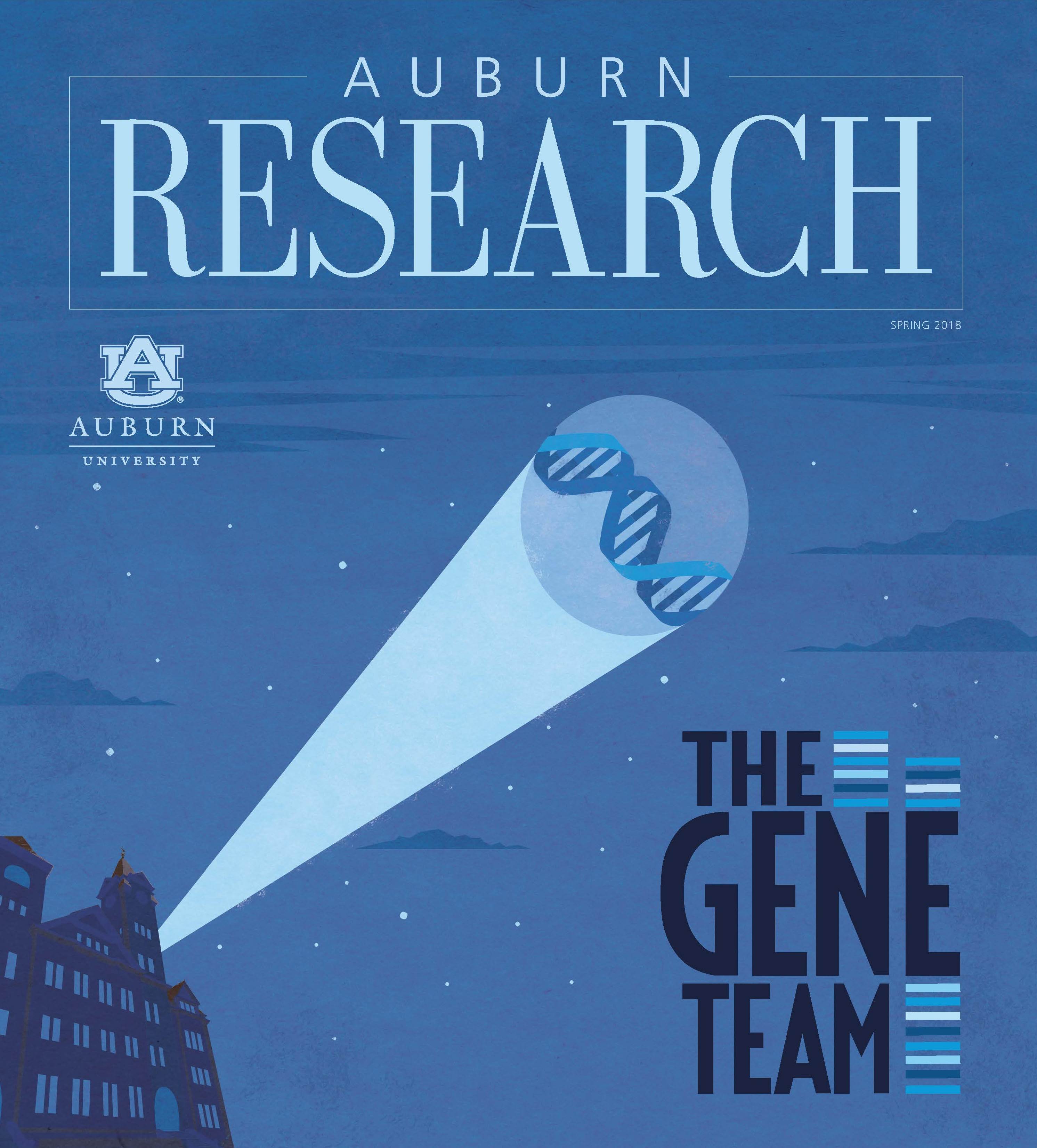 Auburn Research Magazine 2018
Auburn Research Magazine 2018
FROM THE VICE PRESIDENT FOR RESEARCH AND ECONOMIC DEVELOPMENT
As Auburn University continues to move its research efforts forward, we are joined by a strong advocate for research and economic development, President Steven Leath. Since becoming the university’s 19th president in 2017, Dr. Leath has consistently shared with various stakeholders and audiences his vision for growing the research enterprise at Auburn.
With his help and significant, ongoing investments in interdisciplinary research, as well as the dedicated work of researchers across a multitude of fields, Auburn continues to fulfill its purposes as a land-grant institution—instructing students, benefitting the state and region through outreach programs, and discovering and disseminating new knowledge through research which, in turn, promotes economic growth.
Auburn has a lot to be proud of, as you can see in these pages. In the College of Veterinary Medicine, researchers are seeking treatments for devastating diseases such as GM1, Tay-Sachs, and cancer. Auburn’s Samuel Ginn College of Engineering continues to lead critical efforts to provide the next generation of cybersecurity professionals with the best tools for the job. And our College of Architecture, Design and Construction is “bringing history to life” through innovative projects like the digital reconstruction of the March 1965 Bloody Sunday in Selma.
With these projects and other important work underway at Auburn—including expansion of the Auburn Research Park, with help from the Auburn Research and Technology Foundation—it is an exciting time to be involved with the university’s research mission. We are grateful for the solid foundation that has been built here over the years, but we continue looking ahead to even greater successes yet to come, and the future indeed looks bright.
Best regards,
John M. Mason Jr., PhD, PE
STRATEGIC HIRING UPDATE
• The Climate, Human and Earth Systems Sciences (CHESS) cluster participated with North Carolina State University, Duke University, the University of Florida, the University of South Carolina, and the University of Tennessee on a collaborative proposal to establish the Southeastern Climate Science Center, which was awarded by the US Department of the Interior. A number of publications authored by CHESS cluster members were published in prestigious journals, including two papers published in Nature. Also, the first CHESS workshop on Coupled Human-Earth System Solutions for Global Sustainability was held at Auburn University, August 13-14, 2017, with over 50 attendees.
• Health Disparities cluster member Dr. David Chae has assumed the directorship of the College of Human Sciences’ Center for Health Ecology and Equity Research. Other cluster members are actively engaged in NIH- and NSF-funded projects.
• The Omics and Informatics cluster has completed its recruiting. Cluster members are already interacting with the other hires and with faculty on campus to design new experiments and submit grant proposals.
• The Pharmaceutical Engineering cluster has made several faculty hires, and the group is actively engaged in research. Dr. Alexei Kisselev has received a $1 million-plus NIH grant.
• The Scalable Energy Conversion Science & Technology cluster is heavily involved in the US Department of Energy’s RAPID/NNMI (Rapid Advancement in Process Intensification Deployment/National Network for Manufacturing Innovation), which plans to lead process intensification projects for improved energy efficiency.
LEATH BOOSTS RESEARCH WITH PRESIDENTIAL AWARDS, GRADUATE FELLOWSHIPS
Keeping his promise of strong support for research at Auburn University, President Steven Leath has launched a new research and development program to drive collaboration with leading businesses, industries, and government agencies.
The Presidential Awards for Interdisciplinary Research (PAIR) will provide $5 million in the next three years to support Auburn researchers in building competitive teams that will advance major technology developments, scientific discoveries, or scholarly advances with broad economic, health, or societal impact.
“PAIR is one of our first steps in a more aggressive strategy as a partnership university,” said Leath, whose background is in research. “By fueling cross-discipline research and scholarship, we’re sending a signal to industry and government that Auburn is open for business.”
A similar program, launched while Leath was president of Iowa State University, successfully funded research and partnership collaboration in such areas as health sciences and food security.
To further boost the university’s research enterprise, President Leath has also established a new graduate research fellowship program that will significantly enhance the profiles of Auburn’s doctoral and terminal degree graduates as academic and societal leaders.
The Presidential Graduate Research Fellowship program will be offered annually to a select number of highly qualified new students who intend to pursue doctoral and terminal professional degrees in established and emerging areas of excellence.
A minimum of 33 new fellowships will be available to recipients every fall semester. Each award will be for three years and will consist of a $10,000 Presidential Fellowship, a minimum $5,000 Dean’s Fellowship, and a minimum $15,000 graduate research assistantship, along with tuition and fees.
Nominees cannot already be enrolled in a doctoral program at Auburn and must be enrolled for nine hours during fall and spring semesters and at least one hour during the summer semester.
New hires attend a Strategic Hiring Initiative reception in September 2017.
Q & A WITH DR.LEATH
Dr. Steven Leath joined Auburn University as its nineteenth president in June 2017. Here he shares his thoughts on Auburn’s research enterprise and his vision for its future.
What aspects of Auburn University made you want to come here?
The high reputation and respect that Auburn carries immediately stood out to Janet and me, but we didn’t understand the full weight until we got here. It’s such a special place that immediately felt like home, and the people here reassure us every day that we made the right decision.
Whether it’s attending the Auburn Art Walk or walking our dogs on campus, the community atmosphere is so easy to love. We have spent much of our lives in the South, so in many ways, Auburn felt like a great chance to come back home.
Auburn’s land-grant mission carries the same standard to which I’ve been accustomed, and I want to continue to serve that mission. I saw an opportunity to take a great university to the next level, and I’m doing my very best to make that happen.
Tell us a little about your research background.
I grew up working on farms so that’s where I began developing my love for agriculture. My father was a research scientist with the US Department of Agriculture, and he used to take me to his labs and field plots. That experience further piqued my interest in agriculture, science, and research.
In college, I majored in agriculture, plant pathology to be specific, with an emphasis in plant breeding. After earning a PhD, I moved into the academic world where I was an extension specialist and became a professor of agriculture. Eventually I served as the vice president for research at the University of North Carolina.
While in North Carolina, Janet and I started a Christmas tree farm that specializes in Fraser firs. My son operates it today. My background in research and plant pathology was helpful in making it successful from a business perspective as well as something we’ve personally enjoyed.
I’ve always cherished the land-grant mission of using innovation and creativity to make people’s lives better, and that’s why advancing research and scholarship stands as one of my key goals as president.
What parts of Auburn’s research enterprise have you had a chance to engage with during your first few months as university president?
During my first few months on campus, I visited each college and school, and I noticed that our research programs are top-notch. For example, I had the opportunity to attend an event recognizing Auburn’s National Center for Asphalt Technology, and its achievements in infrastructure development are quite impressive. With transportation and infrastructure emerging as a national priority, I see even greater potential to make a name for Auburn through the critical work they do there.
In the College of Veterinary Medicine, the Scott-Ritchey Research Center, with funding from the National Institutes of Health, has produced a novel gene therapy for the treatment of a devastating neurodegenerative disease that is nearing human clinical trials.
Also, the RFID, or radio frequency identification, Lab is a joint venture of the Harbert College of Business, the Ginn College of Engineering, and the College of Human Sciences. They have revolutionized the way retailers track and manage inventory. These and other Auburn researchers are solving problems every day.
Looking to the future, what would you like to see Auburn achieve as a research institution?
It’s important that Auburn achieve the R1 classification that puts us among other universities with the highest levels of research activity. This scale is important for garnering higher quality support to advance our research mission and produce meaningful discovery.
I also want to incentivize interdisciplinary research and scholarship in a way that elevates instruction, builds partnerships with business, industry, and government, creates opportunities for faculty and staff, and creates solutions to state and national challenges.
Finally, I want people to look to Auburn when they need answers to the world’s complex problems. We want Auburn to be recognized as a trustworthy partner to all who are interested.
WARRIOR RESEARCH CENTER
US Army Game Studio develop FAA aviation-training technology
By Morgan S. Martin
Auburn University is collaborating with the US Army and the Federal Aviation Administration (FAA) to develop innovative aviation learning and training modules using virtual, interactive, and multimedia technology. The partnership seeks to develop gaming modules that can be implemented into the FAA’s current curriculum for air traffic controllers.
A cooperative research and development agreement enables Auburn’s Warrior Research Center to join forces with the US Army Game Studio, which is part of the US Army Aviation and Missile Research, Development, and Engineering Center (AMRDEC) at Redstone Arsenal in Huntsville, Alabama. The project is through the FAA’s Air Transportation Center of Excellence for Technical Training and Human Performance, of which Auburn serves as a core team member.
The team will develop air traffic controller training technology using research and science-based knowledge on training adult learners and the use of gaming to improve learning and retention. The modules will demonstrate team capabilities to provide realistic, engaging, and effective training.
AMRDEC’s Army Game Studio has established unmatched capabilities in the development of virtual, interactive, and multimedia technology used for outreach, recruiting, education, and training. The studio brings together artists, soldiers, and gaming experts to create virtual environments for soldiers to train in without putting them at risk in combat. Rapid prototyping of gaming technology tools ensures that the computer-generated training environments are user-friendly and customizable to the soldiers. The studio is best known for developing the free online US Army video game, America’s Army.
“The Army Game Studio is my go-to place for any training, animation, augmented learning, or virtual environment that I need,” said Dr. JoEllen Sefton, director of the Warrior Research Center and associate professor in the School of Kinesiology. “I know that the talented team there can take anything we develop, or anything I can imagine, and make it real.”
A cross-disciplinary effort, the Warrior Research Center is led by the School of Kinesiology in the College of Education and includes research from engineering, industrial design, psychology, business, veterinary medicine, and human sciences. Collaborators also include Auburn’s ROTC program, MRI Research Center, Center for Disability Research and Policy Studies, and Gastrointestinal Research Center, as well as the Edward Via College of Osteopathic Medicine in Auburn. Warrior Research Center investigations include the effects of military vehicles on a body’s skeletal system, blood flow, and muscles; consequences from prolonged helicopter sitting; evaluation of neck injuries from prolonged wear of helmets; reducing injury; and improving warfighter performance. Studies also explore the design of a universal cockpit, controllers, and pilot seats to improve mission efficacy and decrease pilot fatigue and injury.
COST-SAVING SUBSTITUTES
Study aims to spread word about generic drugs
By Matt Crouch
The cost of healthcare in the United States is continually on the rise. With higher insurance premiums, drug prices, and other costs, patients are looking for ways to save money. One of those is the use of generic drugs, an industry that has exploded in the last 10 years.
Generic drugs have made a big impact in controlling costs, with more than $1.2 trillion in savings realized in healthcare expenditures from 2003-12. With the potential savings adding up, the frequency of generic drug prescriptions has escalated as well.
Generic drug usage has increased from 19 percent of total drug spending in 2006 to 28 percent of total drug spending in 2014. In 2014, Americans filled nearly 3.9 billion generic prescriptions, and today, nearly 90 percent of the prescriptions filled in the United States are for generic drugs.
With the increased presence of generic medicines on the market, the need exists to ensure the safety and effectiveness of these medications. For Dr. Jingjing Qian, assistant professor in the Harrison School of Pharmacy’s Department of Health Outcomes Research and Policy, those concerns are the subject of two current research projects she and her co-investigators are pursuing with the support of grants from the United States Food and Drug Administration (FDA).
“The objective of the first project is to understand roles of key groups that are influencing generic drugs and the extent of their influence on generic drug use in order to provide additional and effective educational outreach to meet their informational needs,” said Qian. “We develop educational materials tailored by different informational needs from stakeholders so that they can increase use of generic drugs.
“Additionally, the generic drug approval process has limited generalizability, especially to special populations such as women, children, and older adults with multiple chronic conditions. The objective of the second project is to monitor and ensure successful generic substitution for these special populations, as well as to provide evidence on generic drug safety and effectiveness.”
There is mixed evidence regarding the appropriateness of generic substitution. Furthermore, adverse events associated with generic substitution call attention to the safety and efficacy profiles of generic drugs, especially for special populations with unique physical, biological, and physiological considerations that are not reflected by healthy volunteers or by the typical patient for whom a drug is indicated.
“Our studies will deliver the provision of information to identify research needs and develop strategies to improve monitoring of generic drug substitution in special populations, which can help to overcome barriers to generic drug use in the US,” said Qian.
Regarding the study of groups influencing generic drug use, Qian and her team found that patients, physicians, pharmacists, formulary managers, and policymakers play an important role in generic drug use. Understanding the factors influencing generic drug use can help guide future policy, education, and practice interventions to increase generic drug use.
The other project, looking at generic drugs in special populations, is still ongoing with review and data collection under way. While still in the early stages, some observations on generic substitution practices have been noticed.
“We found that physical characteristics such as taste and smell of certain generic drugs and concerns of adverse events may influence generic drug substitution,” said Qian. “Additionally, some medical guidelines disagree with generic substitution without physician and patient approval consent due to the risk of adverse or compromised clinical outcomes.”
ALABAMA EXTENSION: THE THIRD PILLAR OF THE AUBURN MISSION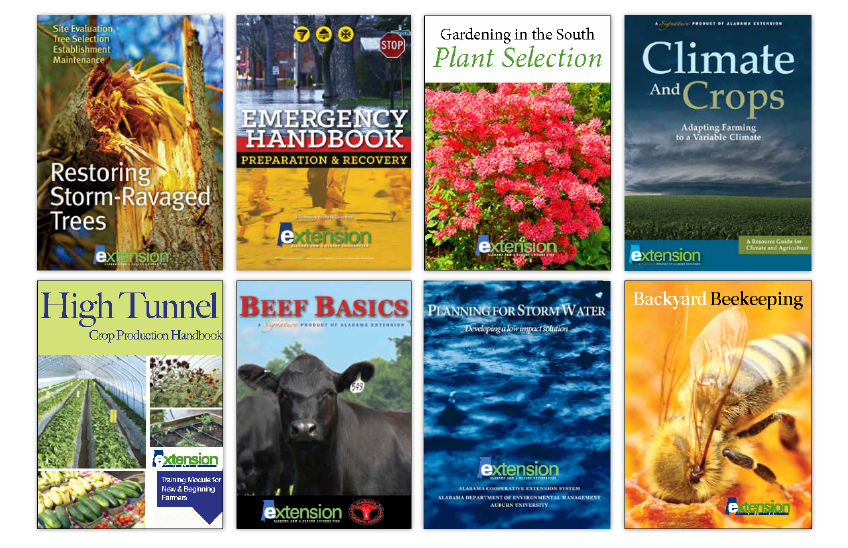
by Jim Langcuster
Recently, Alabama Extension Director Dr. Gary Lemme was served a striking reminder of the enduring value of the third pillar of the land-grant university mission: Extension, which is inscribed along with Research and Instruction on the Auburn University seal.
Taking part in an online Extension seminar, he noticed one of the participants—a farmer—was viewing the conference via his smartphone in the cab of an auto-steered tractor coursing its way down a crop row.
The thought occurred to Lemme: This farmer was being served in a way that embodies the essence of the Extension mission—to reach people where they live and work with practical research-based knowledge.
“It’s what every Extension educator has always striven to do: to provide a gateway to the nation’s network of land-grant universities—to reach Americans from every walk of life with research-based, peer-reviewed knowledge,” Lemme said.
More than a century ago, Congress passed the Smith-Lever Act, establishing a national Cooperative Extension system to secure a crucial link between land-grant universities and the American people, namely by ensuring that ordinary Americans tangibly benefited from land-grant research.
Alabama Extension proudly stands as the third pillar of Auburn’s mission.
“The delivery methods have changed, but the end goal remains the same—to improve lives and to revitalize communities, farms, and local economies,” said Dr. Paul Brown, Alabama Extension associate director, who stresses that the guiding focus of Alabama Extension in recent years has been to reaffirm the critical link between Extension and research.
Another priority is to reaffirm Extension’s longstanding reputation for working closely with stakeholders, forging partnerships to achieve tangible, lasting results, chiefly by securing major returns on public and private investments in Extension programming.
“We’re not interested in just disseminating information,” Brown says. “Our job is to produce lasting, meaningful changes in people’s lives—changes we measure and document.”
This philosophy is summed up in Extension’s core values—“Three Rs”—the research-based nature of Extension programs; Extension’s historic focus on developing close client relationships; and finally, its insistence on providing relevant programming to address the most pressing and current challenges.
These values undergird every facet of Extension programming.
The National Poultry Technology Center is an example of how Extension uses cutting-edge research generated by scientists with the Alabama Agricultural Experiment Station to design and manage poultry housing that enables poultry producers to enhance their economic bottom line.
Through ALProHealth, a partnership forged between Alabama Extension and the US Centers for Disease Control and Prevention—the nation’s first such partnership—nutritionists in 14 Alabama counties work with local citizens, community leaders, and stakeholders to foster effective behavioral strategies to combat obesity.
One Extension client, the owner of a Tuskegee grocery store, has learned how to provide his customers with healthier food and beverage choices and is now purchasing and selling 10 cases of cut-up fruit each week.
Beef Basics, a digital learning experience that combines an online learning course with an iBook, guides beginning beef producers through the management steps required to run a livestock operation.
Graduates of this program reported savings of $93 per head of cattle, for a total of $321,408. With an investment of $6,007 in Alabama Extension staff costs and travel to administer the training, the program secured a return on investment of 53-to-one.
For Alabama cattle producers, the proper development of beef replacement heifers is critical to profitability. Extension educators and local beef producers are working together at the Sand Mountain Research and Extension Center to optimize the production of beef heifers from weaning through breeding and also how to adopt forage grazing and forage measuring techniques to reduce stored feed costs.
Lemme points with pride to how Extension harnessed digital technology to help farmers through the 2016 drought, reaching the state’s beleaguered livestock producers with 80 live and Facebook Live online sessions.
“Alabama Extension reached thousands of producers and generated more than $117 million of additional income for them—and in a time of critical need,” Lemme recalled.
Alabama Extension is also a national leader in the design and production of iBooks, notably the Climate and Crops iBook, released in 2015 and developed in cooperation with Extension and researchers at four Southeastern research universities.
“We’re adjusting to meet new learning styles,” Brown said, adding that people come with radically diverse demands in terms of what they want to know.
“Some are interested only in cursory exposure, some want deep immersion, while others seek full mastery of a topic,” he said. “We must be prepared to meet this spectrum of demands.”
The next major step for Extension is a complete overhaul of its website, which will be completed this year. The new site will be much more intuitive, allowing searchers to quickly find information they need. It will also fully support language translation from English to the other major languages spoken in Alabama.
Many are taking notice of Alabama’s pioneering efforts.
Alabama Extension’s communications and marketing unit, which works closely with the information technology unit to design and produce digital learning products, garnered more awards than any other land-grant institution at the 2017 national conference of the Association for Communication Excellence (ACE). The strongest showing was in the design of digital products including iBooks, online courses and targeted websites.
“Our digital efforts have allowed us to broaden our emphasis on building communities of learning,” Brown said. “Now we’re building digital communities where Alabamians can participate from their tractor cab, place of business, or home.“
“Extension offices in every Alabama county continue to serve as Auburn University’s front door. And now, Extension is as close as the smartphone in your pocket.”
IMPROVING WATER CONDITIONS IN INDIA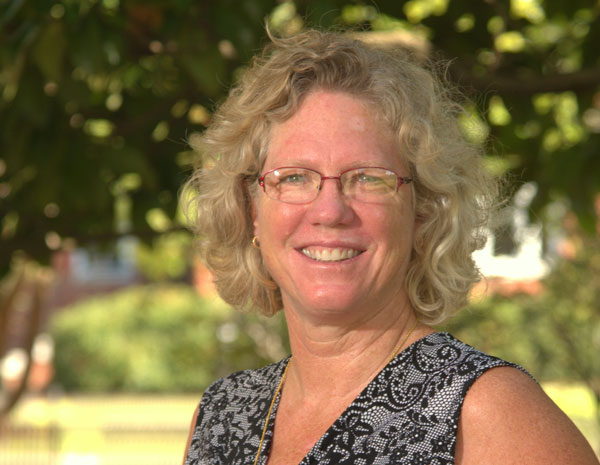
By Vicky Santos
Dr. Kelly Alley, the Alma Holladay Professor of Anthropology in the College of Liberal Arts, has carried out research in northern India for over 25 years. Her focus has been on public culture and environmental issues in the Ganges-Brahmpautra-Meghna basin, combining inquiries into religious practice and doctrine, government policy, law, and activism.
She is past-president of the anthropology and environment section of the American Anthropological Association. She has worked with the World Water Forum and UNESCO to incorporate understanding of cultural diversity into water management, research that has been supported by the Center for Forest Sustainability and the College of Liberal Arts at Auburn. In 2011, Alley was awarded the President’s Outstanding Collaborative Units Award along with members of the Center for Forest Sustainability.
In 2017, Alley presented a paper at the University of Edinburgh. The paper, “Draining Legal Activism: Delay and persistence in India’s legal discourse,” was presented as part of a two-day symposium, Taking Nature to the Courtroom in South Asia. The symposium brought together international scholars with established records on the topics of environmental issues, and the relationship between ecology and religion in South Asia.
“Dr. Alley’s research has proven to be crucial to the environmental issues surrounding India,” College of Liberal Arts Dean Joseph Aistrup said. “Her work continues to merit attention from international leaders and scholars. We are proud and pleased with her collaborations and with the important inroads she’s developed over the past 20 years while conducting research in northern India.”
Recently, the National Science Foundation (NSF) awarded Alley and her collaborators $252,798 to examine the potential of decentralized programs of wastewater management in India.
“Increasing water shortages and contamination have pushed communities and policymakers to reconsider their reliance on centralized wastewater treatment systems and to experiment with decentralized ones,” Alley said.
A decentralized project is a small-scale treatment system operated in a city drain, a neighborhood, or an institutional setting without long distance transfers of wastewater through underground and above-ground pipes. Decentralized plants can save energy and may involve lower maintenance costs.
“But the planning and effective operation of these projects require wholesale changes not only in technology, but also in institutional frameworks and systems of governance, which produces a nexus of effects across scales that is not yet well understood,” Alley said.
According to the abstract Alley submitted to NSF, her team will “study the interactions between institutional structures, governance mechanisms, geophysical landscapes of wastewater flows, and cultural practices in the context of decentralized responses to water contamination and shortage.”
Along with this focus on wastewater problems, Alley has been tracking river flows from the Himalayas for many years. She worked with local officials, environmentalists, geologists, and concerned citizens to put together and maintain a comprehensive and interactive website on river pollution cases and hydropower projects across the Himalayas. Her work through the NSF grant will continue these important efforts. Alley and her team will also produce case studies and will publish their research in academic journals as well as public domain websites so that experiments can be shared across communities and countries. They will research a wide range of decentralized water treatments and pollution-reducing pilot programs in the heavily polluted Ganges river basin, focusing on projects connected to a sample of the 144 drains that pour wastewater into the river system.
“Cleaning up the Ganges is complicated by the fact that the river is, on the one hand, culturally significant as a Hindu goddess while, on the other, it is being diminished by escalating extractions for agriculture, industry, power, and urbanization,” Alley said. “It is the combination of these factors that makes a sample of Ganges-related projects ideal for investigating the intersectional effects of decentralized wastewater treatment approaches.”
Alley said that she and her team will conduct surveys throughout communities and neighborhoods and record the responses to find out how open residents might be to experimental ways to treat polluted water.
“These small-scale projects attempt to treat wastewater to a water quality standard appropriate for horticulture, and in some cases, potable water. The power needs of these systems are lower and in one case solar power runs the system. The possibilities for scaling up these systems to a level that makes a larger contribution to treatment of the gigantic pollution load is in debate,” Alley said.
These smaller water treatment plants produce water for non-drinking purposes, such as gardening, flushing toilets, and industrial uses.
“The biggest problem is the lack of a client base: Who will use this water? Who is willing to pay for it? If industries are not mandated to use recycled water, they will continue to extract precious groundwater at a cheaper price. And if they can continue to dump the effluent into a nearby drain for less cost, they will continue to do that. So strong enforcement is needed to develop industries into clients, and strong community demand for water can develop citizens into clients. However, water in the Ganga basin remains plentiful due to seasonal monsoons and glacial melt, so in some ways communities are buffered by water availability, even if it is contaminated water they are using.”
Alley and her team will also compare responses from citizens in these more water-rich regions with those living in water-scarce regions of southern India. This will help to understand the extent to which reuse occurs in relation to water scarcity.
These tough questions are why Alley is a sought-after and highly respected authority on India’s waterways. It’s also part of the reason she’s such an asset to the university.
“Well, I think that a big [Auburn University] serves the world,” Alley said. “Yes, we are a land-grant and we have an obligation to our state, but we also have an obligation to teach our students about the global context. In that way, my finding will help connect our water issues with those around the world. Also, of course, we’re training graduate students. That’s a really enjoyable facet for me right now, because I’m emailing with graduate students I work with every day saying, ‘check this out,’ ‘let’s read this,’ ‘let’s include this.’ I really like that.”
BRINGING HISTORY TO LIFE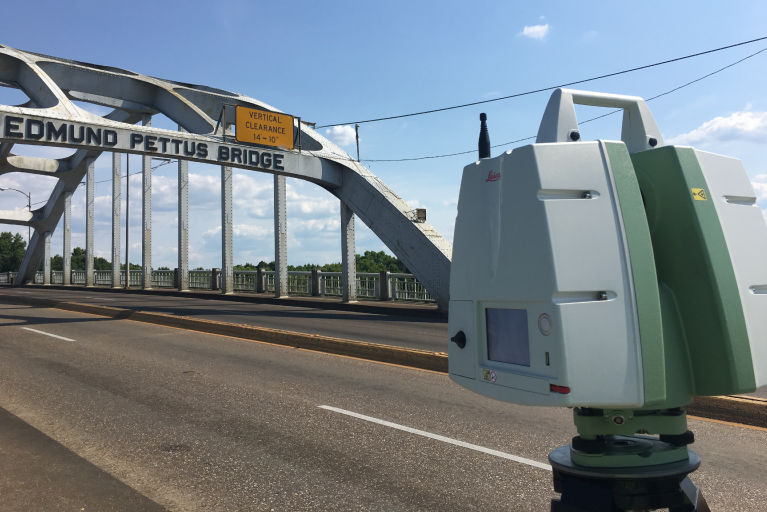
A digital reconstruction of Selma’s Bloody Sunday
By Dr. Danielle Willkens, Dr. Richard Burt, Dr. David Carter, Dr. Keith Hebert, Junshan Liu, and Heather Haley
On March 7, 1965, 600 peaceful civil rights demonstrators prepared to march from Selma to Montgomery, championing the Selma voting rights movement. At the apex of the Edmund Pettus Bridge, 100 feet above the Alabama River, they were met with a daunting view on Route 80: a sea of Alabama state troopers equipped with gas masks and a sheriff’s posse mounted on horseback armed with clubs wrapped in chicken wire. Determined to march on, John Lewis and Hosea Williams led the demonstrators south, but once they passed the invisible line separating the city of Selma from Dallas County, they were attacked with teargas and billy clubs. That night as national television audiences watched the premiere of Judgment at Nuremberg, a film about Nazi war crimes, news broadcasts interrupted the film and brought the gruesome images of this bloody encounter to American living rooms. The attack left 17 marchers hospitalized and 50 treated for lesser injuries. The event was memorialized as Bloody Sunday.
Photographs, movies, documents, personal notes, and artifacts now serve as the records of this conflict, some of which are presented to the general public through museum exhibits or online interfaces. Despite the vivid archival material, there is little that addresses the physical context and experiential timeline of the Bloody Sunday conflict.
Today’s visitors to the Edmund Pettus Bridge see, simultaneously, a National Historic Landmark integral to the civil rights movement and a structure that is named after a Confederate general and grand dragon of the Alabama Ku Klux Klan. Additionally, these visitors see a built and natural environment that has changed dramatically since 1965, presenting an altered perception of the sites surrounding the conflict.
In order to address these discrepancies and enhance public access to interpretive materials on such a critical event in American social history, a multidisciplinary team has been formed to document the present condition of the Bloody Sunday site and generate a digital reconstruction of the area as it appeared on March 7, 1965. In hopes of bringing history to life, the team, led by principal investigator Dr. Danielle Willkens, will ultimately create a digital interface where it will be possible to view the site as it was on Bloody Sunday, through the eyes of marchers, troopers, and onlookers.
To create a dynamic and interactive model, the team for this multiyear project is conducting on-site surveys, searching a number of archives for historic images, and testing the boundaries of digital modeling. In addition to traditional photography and field notes, the team is using modern building construction technology, such as 3D LiDAR, photogrammetry, and UAV (e.g., drone), in their survey of the conflict, site now largely degraded, and they have already identified several elements suitable for future historical preservation projects.
For the on-site survey, Junshan Liu led the team and located 26 stations along US 80 and used two laser scanners to capture a data set known as a point cloud. With multiple scans combined into a single database, the georeferenced point cloud has more than 125 million points and its coordinate system is tied to the Alabama State Plan Coordinate System. This point cloud, in combination with photogrammetry generated by a UAV, serves as a highly accurate database that the team is using to build a 3D digital model of the existing site, complete with topography, buildings, signs, and vegetation.
The composition of the interdisciplinary team has been integral to the project’s development, and this ambitious digital project has already required countless hours of archival research, planning, and coordination with National Park Service staff at the Lowndes County and Selma Welcome Centers. As both a new resident of Alabama and doctoral student at Auburn University, Heather Haley was wholly unfamiliar with the resources available to academic researchers from the state.
While the broader civil rights movement has a well-documented and growing base of historical scholarship, this project ultimately demanded a visit to the state of Alabama’s Photographic Services Division in Montgomery, where she found an extensive collection ranging from the documentation of days leading up to Bloody Sunday to the marchers’ arrival in Montgomery on March 24, 1965. The collection was vital to this project because the numerous photographers present on Bloody Sunday were able to capture different angles of historic structures.
Collected from rich local repositories, the historic images of the area south of the bridge are being processed through an innovative workflow developed by team member Dr. Richard Burt that uses Photomodeler, a digital photogrammetry software to obtain geometric and dimensional data. In order to accomplish this task, at least five control points with known coordinates (X, Y, and Z) must be identified on a single image; the 3D scans and Total Station data from surveys of the extant structures around the site of conflict provide this invaluable information.
Once the control points are marked on the historic photos, the algorithms within Photomodeler calculate coordinate information for the position of the camera and then the points on missing structures such as buildings, signs, and even telephone poles can be marked for further processing, eventually facilitating the generation of geometric and dimensional data for those missing features .
.
Combining the data from the site survey and historic images, the team will be able to create a model of the site from 1965, reconstructing the diners, drive-ins, and car dealerships that once enlivened the area. As the work progresses, the team will look to integrate additional digital modelers and even animators who will help bring the virtual environment to life through planned applications in augmented reality and interactive simulations.
Addressing the relevancy and methods of the project, public historian and team member Dr. Keith Hebert summarizes: “Our project seeks to bring to life the setting of one of the most significant events in 20th-century American history. Taking the past into the digital world offers the public opportunities to explore this landscape for themselves and draw from it experiences that traditional documents cannot recreate.
Digital projects such as this will expose Bloody Sunday’s complicated history to new audiences in a format that will be more engaging than previous efforts to share this momentous event. The future of the past lies in how scholars apply these developing technologies.”
Pictured are the project team: (front row) Dr. Richard Burt (Building Science), Dr. Keith Hebert (History), GRA and PhD candidate Heather Haley (History); (back row) Dr. Danielle Willkens (Architecture, Planning and Landscape Architecture), Junshan Liu (Building Science), and Dr. David Carter (History).
Take 5 with Lori St. Onge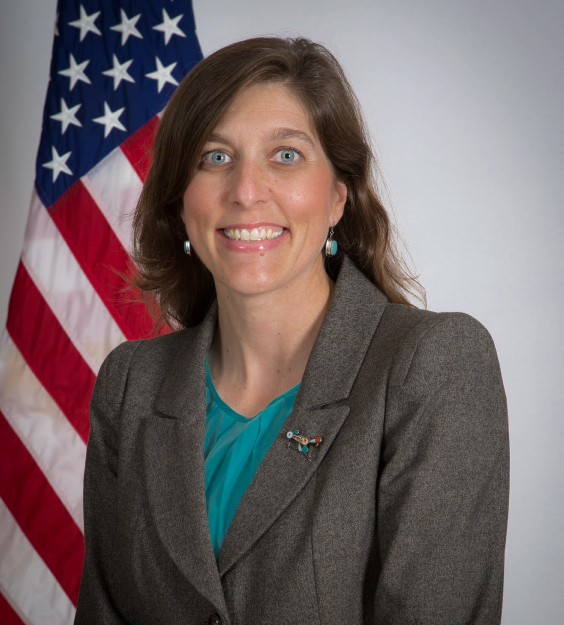
Dr. Lori St. Onge is a longstanding member of the Auburn University Research and Economic Development Advisory Board and chair of its academic affairs committee
Tell us about your affiliation with Auburn.
I earned an undergraduate degree in exercise science from Auburn in 1998 and I played clarinet in the marching band and was a student trainer with the football, swimming and diving, and track and field teams. I earned a doctorate in kinesiology in 2008. My research, completed under the direction of Dr. Mary Rudisill, now director of the School of Kinesiology, focused on increasing student engagement in the classroom by manipulating environmental learning cues fostered by classroom instructors.
In 2008, I began a career at the US Army Aeromedical Research Laboratory, Fort Rucker, Alabama. I am the research administration manager, responsible for supervising the operations of the Science Information Center, including the public affairs and STEM educational outreach programs.
How did you become involved?
In 2009, I was asked to serve as the College of Education’s representative on the Auburn University Research Advisory Board. Service to others, particularly Auburn, is important to me. I truly enjoy the opportunity to learn about Auburn research and scholarly activities and serve on a board that advises Dr. John Mason, Vice President for Research and Economic Development, on matters that advance research at Auburn.
Which of the board’s achievements would you say are the most noteworthy?
The most noteworthy achievements of the Advisory Board include the establishment of the Board’s Advancement of Research and Scholarship Achievement Award, the only research award given by an entity outside of the university to a faculty member, and LAUNCH: The Fund for Research and Innovation, an endowed fund to assist Auburn faculty and students commercialize research. Both the Award and LAUNCH provide recognition and funding to motivate and advance Auburn research and scholarship.
As chair of the Academic Affairs committee, you are involved with the Research and Economic Development Advisory Board Advancement of Research and Scholarship Achievement Award. Tell us about the award.
It’s Auburn’s most prestigious research and scholarship award aimed at recognizing a faculty member who has distinguished himself or herself through high quality, competitive research, and scholarly activity that exemplifies and advances Auburn’s mission. The Research and Economic Development Advisory Board wants to demonstrate that we support Auburn’s efforts to grow a culture in which faculty discover new knowledge, support economic development, and enrich the lives of others within and outside Alabama.
You have had a chance to review a number of applicants’ proposals. What stands out to you about work from Auburn faculty?
I am wowed by the quality and quantity of research and scholarly activity. I am proud of the applicants for demonstrating their dedication to ask difficult questions and develop novel solutions and for their success at sustaining funding, publishing in top-tier journals, transferring technology, mentoring students, and giving back to the community. Auburn faculty are engaging in incredibly impactful research and scholarly activity.
NATIONAL SCIENCE FOUNDATION RECOGNIZES EARLY-CAREER FACULTY
By Lindsay Penny and Candis Birchfield
Three faculty in the College of Sciences and Mathematics were 2016-2017 recipients of National Science Foundation (NSF) CAREER Awards. The NSF Faculty Early Career Development (CAREER) program is a foundation-wide activity that offers the National Science Foundation’s most prestigious awards in support of junior faculty who exemplify the role of teacher-scholars through outstanding research, excellent education, and the integration of education and research within the context of the mission of their organizations.
Chemistry professor is combating red tides
 Auburn University is familiar with battling against a red tide, but this time the foe is coastal red tides that have a significant negative impact on the environment and economy.
Auburn University is familiar with battling against a red tide, but this time the foe is coastal red tides that have a significant negative impact on the environment and economy.
Dr. Steven Mansoorabadi, assistant professor in the Department of Chemistry and Biochemistry, received a five-year, $703,000 NSF CAREER Award to study the problem through his project, “Mechanistic and Biosynthetic Studies of Dinoflagellate Bioluminescence.”
“It’s a very prestigious award, and it’s very humbling,” said Mansoorabadi. “I’m excited that I was selected for the award, and that my science is appreciated by the scientific community. Bringing in the resources to continue this research is great.”
His research looks at dinoflagellates, marine microorganisms found in coastal and freshwater environments that bioluminesce, or glow. Some species of dinoflagellates produce toxins, which can cause harmful algal blooms that discolor coastal waters to brown or red, an occurrence known as a red tide.
“It’s very costly both to tourism and the seafood industry, and is harmful to humans and marine life,” said Mansoorabadi. “It can be detrimental to the environment. Shellfish poisoning is often caused by dinoflagellate toxins, and even breathing in spray from affected waters could cause respiratory problems in humans.”
According to the National Oceanic and Atmospheric Administration, every coastal state in the US has suffered a red tide over the last decade. Harmful algal blooms occurring in American marine waters are conservatively estimated to have an average annual cost of $82 million due to impacts on public health, tourism, and the seafood industry.
Mansoorabadi and his team are looking at the enzyme that causes the dinoflagellate to glow, to better understand how the enzyme works and is regulated.
As part of the NSF funding, Mansoorabadi collaborates with two K-12 outreach initiatives in the College of Sciences and Mathematics, Destination STEM and the Summer Science Institute, to teach and inspire students to pursue careers in the sciences.
“Bioluminescence is really a fascinating phenomenon, and it really gets kids excited about biology and chemistry and science in general,” said Mansoorabadi. “We have a lot of hands-on demonstrations and activities. For some of the younger students, it’s the first time these kids have been on a college campus, so they get to see what it’s all about.”
Prior to joining the faculty at Auburn University, Mansoorabadi was a postdoctoral fellow at the University of Texas, and he received a doctorate from the University of Wisconsin-Madison.
Biologist studies lifelong effects of stressors during development
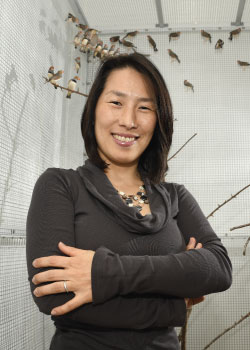 Dr. Haruka Wada, assistant professor in the Department of Biological Sciences, is scientifically proving the old adage, “what doesn’t kill you makes you stronger.”
Dr. Haruka Wada, assistant professor in the Department of Biological Sciences, is scientifically proving the old adage, “what doesn’t kill you makes you stronger.”
“We think we know stress or stressors because we feel them every day, we talk about it every day, but when it comes to the physiology of stress, there are a lot of unknowns, and this is partly because how we respond to stress depends on what we’re feeling that day,” said Wada.
Her project, “Proteostasis to Allostasis: Integration of Cellular and Organismal-Level Stress Responses,” will critically evaluate how a stress response is regulated while improving scientists’ understanding at both the organismal and cellular level. The study is made possible through a five-year, $1,018,132 NSF CAREER Award.
Wada and her team are currently using heat conditioning, a mild stressor applied to juvenile zebra finches the team is raising, as a way to increase stress tolerance in adulthood. For a month, the birds are exposed to mild heat stress for a few hours each day. As the birds become adults, they are exposed to higher levels of heat stress and are able to better tolerate those higher levels.
“So, the question is, what are the physiological changes that allow them to tolerate those stressors later on in life?” said Wada. “In simpler terms, the physiology of what doesn’t kill you makes you stronger. We often consider being under stress as a negative thing, but being under moderate amounts of stress can have positive effects, such as enhancing memory or immune function.”
As part of her NSF CAREER Award, Wada will work with the College of Sciences and Mathematics’ STEM-IQ program. The program trains middle and high school teachers from rural areas within the southeast region of Alabama to promote participation in science fairs and enhance the overall quality of science projects.
Wada is developing a module to educate students about stress and ways to cope with daily stressors. She will open her lab to teachers and students to help them conduct research and prepare for science fairs.
“This research is something I’ve always wanted to do, and the CAREER Award actually allows me to do it,” said Wada. “I’m a stress physiologist by training, and the results of this research will, I hope, make a big difference in our field.”
Playing molecular Lego: Merner explores the complex architecture and construction of creating carbon nanotubes
 Dr. Bradley Merner, the James E. Land Assistant Professor of Chemistry, received a five-year, $700,000 NSF CAREER Award. The funding will allow doctoral students Nirmal Mitra and Caroline Merryman to dedicate their efforts toward assisting Merner in the development of new strategies for the controlled synthesis of carbon nanotubes.
Dr. Bradley Merner, the James E. Land Assistant Professor of Chemistry, received a five-year, $700,000 NSF CAREER Award. The funding will allow doctoral students Nirmal Mitra and Caroline Merryman to dedicate their efforts toward assisting Merner in the development of new strategies for the controlled synthesis of carbon nanotubes.
“This CAREER Award from the National Science Foundation has enabled my research group to work in a very exciting area of chemical synthesis over the next five years,” said Merner.
Carbon nanotubes were discovered in 1991, and today they have broad applications in materials science, engineering, and biological sensing. They are used in batteries, dental implants, electronics, cancer detection, biological and biomedical research, drug discovery, water filtration, and more.
Currently, scientists create carbon nanotubes by synthesizing benzene rings, stacked one on top of the other, continuing from the bottom up, to form a cylindrical carbon nanotube.
Complications stem primarily from carbon’s resistance to adapting to a cyclical molecular structure. The ensuing result is a carbon nanotube that is not uniformly synthesized at best, and completely disintegrated at worst.
The inability to construct uniform carbon nanotubes limits the possibilities and full potential of applications for usage, especially as it relates to research, since research depends upon a uniform control group.
“These hexagons (molecules) can be thought of as a sheet of plywood,” said Merner. “It is really hard to bend a sheet of plywood. Similarly, it is hard to bend benzene rings. Like bending plywood, a lot of strain and potential energy is built into the benzene ring that needs to be released somehow.”
Merner’s group is seeking to discover more effective methods for constructing carbon nanotubes by building smaller sections of carbon nanotube that can be assembled into larger nanotubes in a systematic way.
“It’s like molecular Lego,” said Merner.
In addition, Merner is developing teaching modules for rising junior and senior high school students in the Southeast who participate in COSAM’s Summer Science Institute.
“We are able to offer students a cutting-edge chemistry experience,” said Merner. “Students are learning about chemistry that is really at the frontiers of chemical synthesis.”
Merner has six doctoral graduate students in his lab, including Mitra and Merryman, as well as Kara Johnson, Sydney Jackson, Ana Dmytrejchuk, and Nirob Saha.
PUSHING PEANUTS
By Paul Hollis
 The peanut is one of the most commonly grown and nutritious foods in the world, and Auburn scientists are working to make it even better by breeding new varieties and improving water-use efficiency.
The peanut is one of the most commonly grown and nutritious foods in the world, and Auburn scientists are working to make it even better by breeding new varieties and improving water-use efficiency.
The College of Agriculture’s peanut research program took a giant leap forward in 2017, releasing a new variety and receiving funding for research to help farmers maintain and improve their production in a changing environment certain to include limited water resources.
Though relatively new in the peanut breeding business, the college’s latest variety release has already won accolades for its high yields, resistance to disease, and healthy traits.
AU-NPL 17 is the product of a peanut breeding program operated jointly by the College of Agriculture’s Department of Crop, Soil and Environmental Sciences and USDA’s National Peanut Research Lab in Dawson, Georgia. It’s the first runner-type cultivar released by the program and is well-adapted for growing conditions throughout the Southeast.
Runner peanuts are most commonly used for making peanut butter and are typically grown in Alabama, Georgia, Texas, Florida, South Carolina, Mississippi, and Arkansas. They account for 80 percent of the estimated 1.5 million acres of peanuts grown in the United States, with Alabama growers planting approximately 200,000 acres this past year.
While the Auburn peanut breeding program is the youngest of its kind in the Southeast, it is rapidly making a name for itself, said Dr. Charles Chen, a former USDA Agricultural Research Service research geneticist who in early 2012 joined the College of Agriculture and is a professor of peanut breeding and genetics.
“With the release of this first runner-type variety, we’re establishing a research pipeline,” Chen said. “Now we’ll be able to make new crosses or selections and other varieties can be released through the program. There’s always something to improve upon—you never reach perfection. That is why we are here.”
Future releases will build on AU-NPL 17’s high yield, disease resistance, and other factors. “You can never totally suppress pests if you continue to grow a cultivar in the field,” he said. “By nature, pests will mutate and fight resistance and tolerance, so resistance eventually will be conquered by pest mutations.”
AU-NPL 17 has been tested throughout Alabama, Georgia, Mississippi, and North Carolina where runner-type peanuts of a medium maturity group are adapted, he said.
“It has shown good adaptability, with its primary advantage being high yields and good adaptation from irrigated fields to non-irrigated, from single to twin-row patterns, and when grown with or without fungicide treatments,” Chen said.
In terms of yield per acre, AU-NPL 17 compares favorably with Georgia-06G—the University of Georgia release that has been the gold standard of Southeastern growers for several years now. AU-NPL 17 also is resistant to tomato spotted wilt virus and tolerant to leaf spot disease, both primary pest concerns for Southeastern growers.
“In tests without fungicide treatments, AU-NPL 17 is generally more resistant or tolerant to tomato spotted wilt virus, early and late leaf spot, and white mold than other cultivars in the test,” Chen said.
Auburn’s new peanut release is also high-oleic, meaning it contains a higher amount of oleic acid compared to standard peanuts. Oleic acid is a monounsaturated fatty acid, also known as a “good fat,” that reduces the amount of LDL (bad cholesterol) while boosting the levels of HDL (good cholesterol). Monounsaturated fats are commonly found in foods such as nuts, seeds, olive oil, canola oil, and avocados. This trait also substantially improves the shelf life of peanuts and peanut products.
“The industry is demanding a high-oleic peanut,” Chen said. In fact, Mars Chocolate—one of the top five peanut buyers globally—has committed to using 100-percent high-oleic peanuts in their products by the end of this year.
“We don’t produce as many high-oleic peanuts in the US as countries such as Argentina and Australia, and that hurts our competitiveness internationally,” Chen said. “I believe high-oleic will provide more options for the American peanut industry.”
While the peanut cultivar breeding process typically takes about 10 years to complete, Chen was able to shorten it by a couple of years by growing peanuts in Puerto Rico during the winter months. “Peanut breeders can send seed to Puerto Rico in November and then get increased seed back at the end of March to speed up the process,” he said. “We did that for two seasons, so it gave us a shorter interval with this cultivar.”
Dr. John Beasley, professor and head of Auburn’s Department of Crop, Soil and Environmental Sciences, says AU-NPL 17 should prove to be of tremendous benefit to growers in Alabama and throughout the Southeast. Beasley should know—he was a peanut agronomist at the University of Georgia for 30 years before coming to Auburn.
“We’re very excited for Dr. Chen and his program,” Beasley said. “In addition to outstanding yields, this new cultivar also has resistance to some of the more common peanut diseases and, even more importantly, it has high oleic acid which is now being required by the industry and demanded by consumers. AU-NPL 17 should be an especially good fit for Alabama producers since it was developed and tested in the state, and it should help growers lower their seed and overall production costs.”
Breeding for drought tolerance
Future breeding work will focus on, among other things, traits that enable more efficient plant water use, Beasley said. This would prove beneficial for producers in Alabama, where a majority of the cropland is not irrigated.
Boosting these research efforts will be a $294,000 grant funded through a partnership of USDA’s National Institute of Food and Agriculture (NIFA) and the National Peanut Board. Auburn’s grant is one of four totaling $1.4 million, with other recipients being USDA’s Agricultural Research Service, Southern Region; Virginia Polytechnic Institute and State University; and Texas A&M University.
The total project, which consists of $1 million from NIFA and $400,000 from the peanut board, focuses on two issues: the accurate diagnosis of peanut and food allergies and continuous improvements in water-use efficiency in peanuts.
“Adequate water availability for all crops is an increasing concern due to competition for water resources and increased drought frequency,” said Chen. “While peanuts are relatively drought tolerant compared to other crops, they’re still susceptible, and Alabama lags behind neighboring states in the amount of cropland that is irrigated.”
The overall goal of the research is to develop near-term solutions that can be implemented by peanut producers to mitigate drought, improve water-use efficiency and improve the environmental footprint of peanut production, he said.
Chen, who is working with the National Peanut Research Laboratory on the latter issue, said there are three objectives to the research he is leading.
“From a genetic or breeding standpoint, we want to find any genetic tolerance to drought,” he said. “We want to find those genetic materials and integrate the drought-tolerant trait into the breeding program.”
Objective two, Chen said, is to determine what kind of gene controls drought tolerance and understand that mechanism from a genetic perspective.
“The third objective, which involves more applied research, will be to develop irrigation schemes that enhance water-use efficiency, improve nutrient uptake, and maintain or improve yield and quality with the best economic returns for drought-tolerant cultivars and breeding lines,” he said.
Mitigating drought in peanuts also will play a role in food safety, Chen said. “If drought negatively affects yields, it can predispose peanuts to aflatoxin contamination, which limits their suitability for human consumption.”
To help identify drought tolerance in peanuts and facilitate the development of new, drought-tolerant varieties, researchers will take an integrated approach that utilizes agronomy, physiology, molecular biology, and genetics.
In addition to Chen, members of the research team include Auburn Department of Crop, Soil and Environmental Sciences faculty members Yucheng Feng and Audrey Gamble; research associate Kris Balkcom; Ron Sorenson, Marshall Lamb and Phat Dang of the National Peanut Research Lab; and Texas A&M faculty member Julie Howe.
Chen is also a member of the Peanut Genome Consortium--an international team of scientists that recently unveiled the map of the cultivated peanut’s entire genome, marking the completion of a rigorous five-year research project.
This genetic breakthrough will allow scientists to pinpoint beneficial genes in cultivated and wild peanuts and use those in breeding new varieties.
FACULTY RESEARCH HIGHLIGHTS
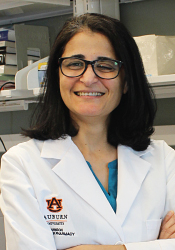 Dr. Amal Kaddoumi joined the Harrison School of Pharmacy Department of Drug Discovery and Development in 2017. She is a graduate of Kuwait University in Kuwait and Nagasaki University in Japan. She completed postdoctoral work at the University of Michigan and the University of Washington. Kaddoumi is the recipient of a National Institutes of Health R series grant that focuses on olive-derived oleocanthal as a molecule that restores cerebrovascular function. Specifically, she is studying oleocanthal’s ability to enhance the functionality of the blood brain barrier (BBB). By enhancing the BBB’s intactness and function, oleocanthal could prevent and treat diseases such as Alzheimer’s.
Dr. Amal Kaddoumi joined the Harrison School of Pharmacy Department of Drug Discovery and Development in 2017. She is a graduate of Kuwait University in Kuwait and Nagasaki University in Japan. She completed postdoctoral work at the University of Michigan and the University of Washington. Kaddoumi is the recipient of a National Institutes of Health R series grant that focuses on olive-derived oleocanthal as a molecule that restores cerebrovascular function. Specifically, she is studying oleocanthal’s ability to enhance the functionality of the blood brain barrier (BBB). By enhancing the BBB’s intactness and function, oleocanthal could prevent and treat diseases such as Alzheimer’s.
 Dr. David H. Chae joined the College of Human Sciences in 2016 as an associate professor in human development and family studies and director of the Center for Health Ecology and Equity Research. Chae studies health disparities and the implications of stressors experienced by minorities. A particular focus of his research is on discrimination, often associated with poor mental health, harmful health behaviors, and indicators of chronic disease risk. Chae examines pathways linking discrimination and health, including family and relationship dynamics, dimensions of group identity, and implicit in-group bias.
Dr. David H. Chae joined the College of Human Sciences in 2016 as an associate professor in human development and family studies and director of the Center for Health Ecology and Equity Research. Chae studies health disparities and the implications of stressors experienced by minorities. A particular focus of his research is on discrimination, often associated with poor mental health, harmful health behaviors, and indicators of chronic disease risk. Chae examines pathways linking discrimination and health, including family and relationship dynamics, dimensions of group identity, and implicit in-group bias.
 Dr. Paul Dyce joined the College of Agriculture’s Animal Sciences Department in 2015 as an assistant professor of reproduction and development. His research interests include the characterization and differentiation of skin derived stem cells into oocytes, the importance of cellular communication during folliculogenesis, and various aspects of livestock reproductive health. His lab is focused on improving embryo, heifer, and gilt selection with the goal of improving the efficiency of these production parameters through a relatively noninvasive test that could potentially save cow-calf producers millions of dollars per year.
Dr. Paul Dyce joined the College of Agriculture’s Animal Sciences Department in 2015 as an assistant professor of reproduction and development. His research interests include the characterization and differentiation of skin derived stem cells into oocytes, the importance of cellular communication during folliculogenesis, and various aspects of livestock reproductive health. His lab is focused on improving embryo, heifer, and gilt selection with the goal of improving the efficiency of these production parameters through a relatively noninvasive test that could potentially save cow-calf producers millions of dollars per year.
 Valerie Friedmann, MLA, Associate ASLA, and assistant professor of landscape architecture, joined Auburn in 2015. Her research focuses on novel plant communities in relationship to infrastructure landscapes. Through a collaboration with Alabama Cooperative Extension Service and AU facilities management, she is investigating the ecological performance and design potential of plant communities found along roadsides in the Mobile Bay area. Her work unites design-build expertise, outreach scholarship, and construction and maintenance methods to address the conflict between roadside maintenance operations and the advantages of roadside vegetation.
Valerie Friedmann, MLA, Associate ASLA, and assistant professor of landscape architecture, joined Auburn in 2015. Her research focuses on novel plant communities in relationship to infrastructure landscapes. Through a collaboration with Alabama Cooperative Extension Service and AU facilities management, she is investigating the ecological performance and design potential of plant communities found along roadsides in the Mobile Bay area. Her work unites design-build expertise, outreach scholarship, and construction and maintenance methods to address the conflict between roadside maintenance operations and the advantages of roadside vegetation.
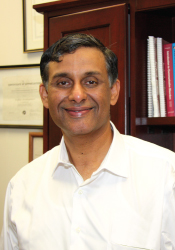 Dr. Sridhar Krishnamurti, Audiology professor, from the Department of Communication Disorders in the College of Liberal Arts, and Dr. Stephanie Karsh, an audiologist from the US Army Aeromedical Research Laboratory in Fort Rucker, Alabama, have been selected for funding for a tinnitus fMRI study from the US Army Military Operational Medicine Research Program, or MOMRP. The ambitious study will receive funding of $870,000 and will focus on fMRI technology, tinnitus treatment devices, and research support. MOMRP develops effective countermeasures against stressors and maximizes health, performance, and fitness. Their mission is protecting the soldier inside and out, at home and on the battlefield.
Dr. Sridhar Krishnamurti, Audiology professor, from the Department of Communication Disorders in the College of Liberal Arts, and Dr. Stephanie Karsh, an audiologist from the US Army Aeromedical Research Laboratory in Fort Rucker, Alabama, have been selected for funding for a tinnitus fMRI study from the US Army Military Operational Medicine Research Program, or MOMRP. The ambitious study will receive funding of $870,000 and will focus on fMRI technology, tinnitus treatment devices, and research support. MOMRP develops effective countermeasures against stressors and maximizes health, performance, and fitness. Their mission is protecting the soldier inside and out, at home and on the battlefield.
 Dr. Brian Thurow, the W. Allen and Martha Reed Professor and chair of the Department of Aerospace Engineering in the Samuel Ginn College of Engineering, is principal investigator on a new $1.1 million grant from the National Science Foundation to develop a single-camera imaging system capable of capturing high-speed and 3D measurements in practical flow fields. The grant will help Thurow and his team develop better hardware and software for this technology, which has applications ranging from health care to the aerospace industry. The research team also consists of Auburn faculty David Scarborough, Vrishank Raghav, and Stanley Reeves and Pavlos Vlachos of Purdue University.
Dr. Brian Thurow, the W. Allen and Martha Reed Professor and chair of the Department of Aerospace Engineering in the Samuel Ginn College of Engineering, is principal investigator on a new $1.1 million grant from the National Science Foundation to develop a single-camera imaging system capable of capturing high-speed and 3D measurements in practical flow fields. The grant will help Thurow and his team develop better hardware and software for this technology, which has applications ranging from health care to the aerospace industry. The research team also consists of Auburn faculty David Scarborough, Vrishank Raghav, and Stanley Reeves and Pavlos Vlachos of Purdue University.
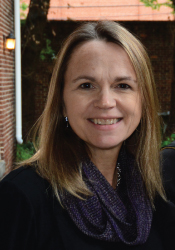 Christine Schnittka, PhD, associate professor in the College of Education’s Department of Curriculum and Teaching, leads the design and development of STEM teaching kit curricular interventions as part of the “Kindergarten Saves the World!” project funded by a grant from 100Kin10, helping prepare 100,000 new K-12 STEM teachers by 2021. The project aligns the existing “Save the Animals” middle-school curricula designed by Schnittka to kindergarten standards. It also ensures that activities and materials are engaging and age-appropriate for kindergarten pupils. Dr. Schnittka, working in conjunction with Loyola Marymount University and the California Science Center, coordinates these activities and manages graduate students working on this project.
Christine Schnittka, PhD, associate professor in the College of Education’s Department of Curriculum and Teaching, leads the design and development of STEM teaching kit curricular interventions as part of the “Kindergarten Saves the World!” project funded by a grant from 100Kin10, helping prepare 100,000 new K-12 STEM teachers by 2021. The project aligns the existing “Save the Animals” middle-school curricula designed by Schnittka to kindergarten standards. It also ensures that activities and materials are engaging and age-appropriate for kindergarten pupils. Dr. Schnittka, working in conjunction with Loyola Marymount University and the California Science Center, coordinates these activities and manages graduate students working on this project.
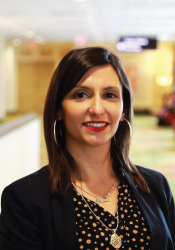 Dr. Maria Soledad Peresin, Assistant professor, joined the School of Forestry and Wildlife Sciences and the Forest Products Development Center as part of Auburn’s Strategic Hiring Initiative in 2016. Her research specializes in the development of value-added materials from renewable biomass, surface chemistry and interactions of plant cell wall components-(nano)cellulose, hemicelluloses and lignin-and their utilization in novel applications such as films for packaging industry, engineered high-strength materials and drug delivery. At Auburn, she has launched several projects dealing with utilization of biomass for value-added materials, in collaboration with both internal and external research partners.
Dr. Maria Soledad Peresin, Assistant professor, joined the School of Forestry and Wildlife Sciences and the Forest Products Development Center as part of Auburn’s Strategic Hiring Initiative in 2016. Her research specializes in the development of value-added materials from renewable biomass, surface chemistry and interactions of plant cell wall components-(nano)cellulose, hemicelluloses and lignin-and their utilization in novel applications such as films for packaging industry, engineered high-strength materials and drug delivery. At Auburn, she has launched several projects dealing with utilization of biomass for value-added materials, in collaboration with both internal and external research partners.
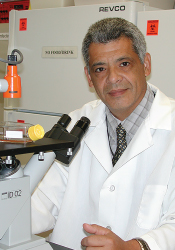 Dr. Haroldo Toro, a professor in the Department of Pathobiology at the College of Veterinary Medicine, focuses his research on understanding chicken anemia virus and its interactions with other avian pathogens, and the role of infectious bronchitis virus in respiratory disease of commercial chickens. Toro has also focused on other relevant avian diseases. He has published 93 articles in peer-reviewed international journals and is a member of the editorial board of the Avian Diseases journal. Toro was awarded the Pfizer Award for Research Excellence, L.G. Wolfe Award for Excellence in Graduate Education, Auburn Alumni Professorship, and the P.P. Levine Award by the American Association of Avian Pathologists.
Dr. Haroldo Toro, a professor in the Department of Pathobiology at the College of Veterinary Medicine, focuses his research on understanding chicken anemia virus and its interactions with other avian pathogens, and the role of infectious bronchitis virus in respiratory disease of commercial chickens. Toro has also focused on other relevant avian diseases. He has published 93 articles in peer-reviewed international journals and is a member of the editorial board of the Avian Diseases journal. Toro was awarded the Pfizer Award for Research Excellence, L.G. Wolfe Award for Excellence in Graduate Education, Auburn Alumni Professorship, and the P.P. Levine Award by the American Association of Avian Pathologists.
THE GENE TEAM
by Mitch Emmons and Janet McCoy
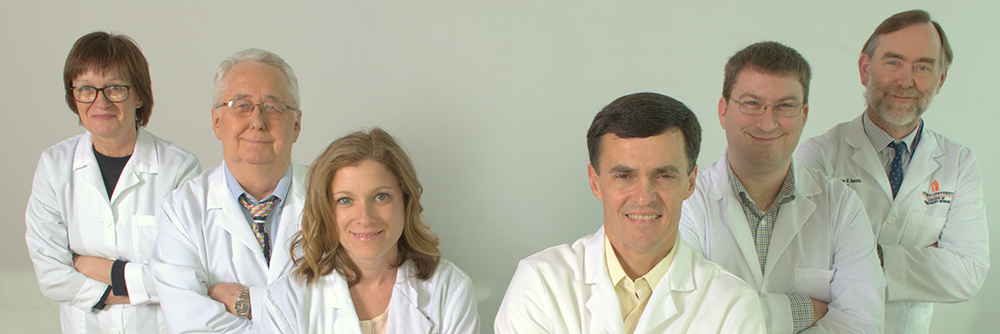
Genetic disorders and diseases caused by failure of mechanisms that regulate gene expression, or the processing of gene products, can have devastating effects on both humans and animals. Pioneering advances in gene therapy and molecular medicine at the Auburn University College of Veterinary Medicine (CVM), one of which is nearing human clinical trials, hold promise for a brighter, healthier future for us all.
In the Scott-Ritchey Research Center, CVM scientists Dr. Doug Martin and Dr. Heather Gray-Edwards lead efforts on GM1, Tay-Sachs (TSD) and Sandhoff (SD) disease research. With several years of documented success in animal models, a therapeutic strategy for treatment of GM1 gangliosidosis should enter human clinical trials in the coming year.
GM1 gangliosidosis is a rare, inherited neurological disease. A lysosomal storage disease that attacks the brain and spinal cord, it is a progressive, degenerative condition that is always fatal in children. This genetically heritable disease affects about one in 200,000 people. These diseases are also found in cats, dogs, and sheep. By taking advantage of a unique feline model developed at the Scott-Ritchey Research Center, the Auburn CVM research team has developed a gene therapy protocol that has proven to be successful in treating GM1. Moreover, their findings could lead to refinement of gene therapies for other neurologic diseases.
“The technology developed for GM1 treatment could be applied to any number of diseases, like Alzheimer’s, which may turn out to be an unusual form of a storage disease like GM1,” Dr. Martin said. “Our vector could have much broader implications and theoretically, the same technology used to treat GM1 could also treat Alzheimer’s.”
Dr. Martin and Dr. Gray-Edwards are members of the Tay-Sachs Gene Therapy Consortium, an international collaborative group of scientists committed to searching for a cure. This team developed and tested a delivery system, or “vector” based on the adeno-associated virus (AAV).
The vector is currently being made at Nationwide Children’s Hospital in Columbus, Ohio, one of America’s largest pediatric health care and research centers.
A toxicity study on mice with the vector is scheduled for late November, and once that hurdle is passed, the company will begin to produce the vector for human clinical trials, which is expected to be in 2018 at the NIH.
“The toxicity study is just one of several safety regulations the FDA requires before we can begin human clinical trials,” Dr. Martin said. “We feel confident that the vector will pass this test and we will be in production soon.”
The development of a treatment for GM1 gangliosidosis using AAV gene therapy was initiated in 2005 by Dr. Martin, currently a professor in the Department of Anatomy, Physiology and Pharmacology at Auburn, and Dr. Miguel Sena-Esteves, an associate professor in the Neurology Department at the University of Massachusetts Medical School.
GM1 glangliosidosis is caused when the body does not produce enough of a specific enzyme, beta-galactosidase (beta-gal), which recycles molecules from the body. When the molecules build to abnormal levels, they progressively destroy the body’s nervous system. The earlier the onset in children, the more quickly the disease kills.
Dr. Sena-Esteves and Dr. Martin re-engineered the virus to introduce the gene that produces beta-gal. The virus acts as a vessel, its genetic material is removed and replaced with a concentrated dose of the beta-gal gene. Healthy cells pass along beta-gal, essentially allowing deficient cells to soak in the crucial enzyme.
The experimental gene therapy has extended the lives of cats, which have a similar genetic defect, from an average of eight months to more than 57 months, with no ill effects, and with normal function.
“There is no question now that the disease can be treated successfully,” said Dr. Martin. “We have seen how it has worked in cats that have the disease and how it is has extended their lives as healthy animals.”
Dr. Martin and a team of researchers have found success in administering the virus two ways: The first, and most successful, is by intracranial injections through the skull, which has succeeded in getting therapy beyond what is called the blood-brain barrier. Because of the risk of brain injection – especially in children already suffering from a neurologic disease – a less invasive alternative is now on the fast track for human clinical trials.
This second method is the development of an intravenous treatment which provides sufficient doses to the brain through the blood system.
“This method has proven successful, but we have to administer more of the vector to ensure enough of it is in the brain,” he added.
This team has also achieved similar success in the treatment of animals with GM2 gangliosidosis (Tay-Sachs and Sandhoff disease). Both cats with Sandhoff disease and sheep with Tay-Sachs benefited from gene therapy devised by this team. Human clinical trials are also in the planning stages for Tay-Sachs and Sandhoff disease.
Gene therapy studies in Tay-Sachs sheep are particularly important because the scientists have successfully demonstrated the same therapeutic principle in a brain similar in size to that of a child. These results indicate that the same success may be possible in a child’s brain, says Dr. Heather Gray-Edwards, an assistant research professor at the Scott-Ritchey Research Center.
“We now only need to raise more funding to be able to take these therapies to clinical trials in human medicine,” Dr. Gray-Edwards said.
Other advances in gene therapy and molecular medicine at the CVM
The College of Veterinary Medicine is also home to other cutting-edge research programs at the molecular level focused on cancer and other diseases.
In his laboratory at the Scott-Ritchey Research Center, Dr. Bruce Smith, a professor in the Department of Pathobiology, is seeking cures for both muscular dystrophy and cancer using gene therapy, and by monitoring immune responses to therapy.
In muscular dystrophy research, Dr. Smith has identified X-linked Duchenne-like muscular dystrophy (DMD), in four different dog breeds. He has found the mutations in three of these breeds (Welsh Corgi, Labrador Retriever, Labradoodle). They are currently working on identifying the cause in the fourth breed, the English Springer Spaniel.
In cancer research, Dr. Smith is working to create new treatments for a wide range of cancers in both dogs and people. His current work is focused on developing oncolytic viruses. These are viruses that are engineered to infect and replicate inside cancer cells. They kill the cancer cell directly, by destroying it from the inside, and also by attracting the attention of the immune system.
Initial clinical trial results in dogs with bone cancer garnered promising results, and the group is now developing the second and third generations of the virus.
Dr. Valery Petrenko, a professor in the Department of Pathobiology, pioneered use of bacterial viruses (bacteriophages) in molecular medicine. He and Dr. James Gillespie, an assistant research professor in the same department, are collaborating in research focused on developing targeted anti-cancer nanomedicines.
“We use a library of different bacterial virus (bacteriophage) particles to identify protein sequences that are over-expressed on the surface of different types of cancer cells,” Dr. Gillespie said. “We have studied the interaction of these modified viral particles with different subtypes of breast, prostate, lung, and pancreatic cancer cells. The proteins from these cancer cell-specific virus particles are then isolated and used to create cancer cell-specific nanoparticles that can specifically deliver a therapeutic molecule (e.g., small molecule drugs or siRNAs).”
Traditionally, targeted nanomedicines identify proteins that are over-expressed on the surface of tumor cells, or on the blood vessels in tumors, and rely on defects in tumor blood vessels for their increased tumor-killing ability, he added.
“Recently it has been suggested by us and other groups that the role of the tumor microenvironment may be preventing the efficacy of some nanomedicines to reach their full potential,” Dr. Gillespie said.
Dr. Tatiana Samoylova, a research professor with Scott-Ritchey Research Center and the Department of Pathobiology, is focused on development of contraceptive vaccines for wild and feral animals. Her research involves cats, dogs, and pigs, using phage as a vector for immunogenic peptides.
Such contraceptive vaccines are composed of whole phage particles carrying immunogenic peptides, where the phage body plays the role of a carrier protein/adjuvant and multiple peptide copies stimulate production by the animal of anti-peptide antibodies. These antibodies interfere with male and female reproductive functions, leading to reduction in fertility.
“Examples of antigens used in our laboratory for vaccine construction include zona pellucida-binding peptides as well as molecules derived from reproductive hormones and their receptors,” Dr. Samoylova said. “One of our projects is directed towards development of a novel type contraceptive vaccine for feral cats and stray dogs to be used as an alternative to surgical castration. A single dose, non-surgical sterilant that could be administered in the field at a reasonable cost would be an ideal solution, and would save lives and end suffering for millions of companion animals throughout the world. The goal is to create a vaccine that will fulfill these requirements.”
The vaccine is designed to include phage particles carrying multiple copies of gonadotropin releasing hormone (GnRH) peptides, she explains. Animals respond to such vaccines by producing anti-GnRH antibodies, which are known to affect fertility, reducing or preventing pregnancies. Other uses of such GnRH-based vaccines may be in the treatment of human and animal hormone-dependent reproductive cancers.
“Contraceptive vaccines for wild pigs is another major area of our research,” Dr. Samoylova said. “Populations of wild pigs are rapidly expanding throughout the United States, causing annual losses of up to several billion dollars in damages to agriculture and other areas of the economy. Current control programs that focus on wild pig eradication through trapping and hunting are expensive, inefficient, and unacceptable for much of the public. Unlike any other contraceptive for wildlife, our approach allows development of vaccines that are species-specific.”
Species specificity is one of the major requirements for an ideal contraceptive for wildlife since such vaccines need to be distributed in uncontrolled environments where they could contact non-target species, resulting in unwanted loss of fertility in the non-target animals, she adds. The approach is unique and protected by
US Patents. Potentially, it can be applied to population control of multiple wildlife species.
In addition to established gene therapy and molecular medicine research programs at the College of Veterinary Medicine, recent additions to the faculty through the Strategic Hiring Initiative in both pharmaceutical engineering and omics/informatics bring broader strengths to this promising field of research and discovery.
WORKING TOGETHER TO WEATHER STORMS
Active hurricane season reinforces need for agency, industry collaboration
By Troy Johnson
As Florida braced for a potential hit by Hurricane Irma, local, state, and federal officials wrestled with the same questions and concerns as their counterparts in Texas did before Hurricane Harvey. When should citizens be evacuated? How should volunteers be utilized? Where should critical supplies be stored and who will distribute them? How could businesses and government entities develop rescue and relief staging areas after the storm, and for how long?
Dr. Glenn Richey, a supply chain professor in the Raymond J. Harbert College of Business, saw firsthand the problems that can surface for governmental agencies and private businesses while living in Tuscaloosa, Alabama, in April 2011. An EF-4 tornado ripped through the community, killing 64 and injuring 1,500. Trailers packed with supplies for displaced residents filled shopping center parking lots which, in turn, created challenges for retailers and transportation companies eager to resume business.
“Local businesses said on Monday morning, `We want to go back to work,’” recalled Richey, Harbert College’s Eminent Scholar in Supply Chain Management. “Response teams had taken command of their parking lots and some delivery equipment. The supplies in those trailers were for people who had their homes destroyed—people who had no water and only the clothes on their backs. What do you do? These people also need to make a living. Do you go back to business as usual, or do you step up and do what you can to help the community?”
Having weathered Hurricanes Elena and Frederic in Mobile, civil unrest in Europe, as well as an EF-5 tornado and a terrorist event while living in Oklahoma City, Richey has seen his share of disasters and, unfortunately, more than a few botched relief efforts. Richey and co-authors Colin Gabler of Ohio University and Geoff Stewart of the University of Louisiana recently published an article in the Journal of Business Logistics that offers a potential solution.
Their article, “Disaster Resilience Through Short-Term Collaboration,” suggests the development of a governing framework and knowledge management system that bridges logistics and communications gaps between public and private entities in the wake of natural and manmade disasters. Richey suggests the development of formal partnerships that would connect private businesses with officials from FEMA, Homeland Security, and state and local agencies charged with responding to hurricanes and other threats. Such short-term, public-private partnerships would work collaboratively to share and manage resources and information, coordinate personnel engaged in rescue and recovery efforts, and re-open supply chains to mitigate shortages of food, fuel, water, and critical services.
Richey notes, “The framework must be flexible and quickly developed to support both the public and private sectors. It must be fair to businesses and fair to the community. More than anything, we need to collect the knowledge related to every event so we can improve our future planning and execution. And we just cannot ignore the power and importance of private industry in impacted areas.”
In Texas, Hurricane Harvey dumped more than 50 inches of rain, killed more than 60, displaced more than 1 million and damaged approximately 200,000 homes—all adding up to an estimated price tag of $180 billion. The storm interrupted power to more than 300,000 homes and interrupted fuel refinement and distribution.
“We need to ensure that everyone is focused on one outcome, understand the roles of each group, and build their goals together so they can save lives,” Richey said. “If a hurricane hits, you’ve got to have the businesses in that community willing to cooperate with the government and share the information that they have, and have the government share important information as well.”
Management of volunteers and donated supplies represents one of the most challenging aspects of post-disaster recovery. A recent CBS News story highlighted logistical problems that have undermined relief efforts for Hurricane Mitch in 1998 and the Indian Ocean tsunami of 2004, among others. Closed ports or airfields make it unlikely that supplies will reach those who need them the most in a timely manner. The story described how donated clothing in the wake of the Indian Ocean tsunami sat and eventually rotted because relief workers didn’t have enough time to sort and clean items.
“The thinking is that these people have lost everything, so they must need everything,” former Center for the International Disaster Information Director Juanita Rilling told CBS News.
What they may need the most, Richey suggested, is close coordination between governmental agencies with the resources to help and businesses with local knowledge and specific expertise.
“My research has pushed me to question why our governments spend so much time trying to protect us against businesses. Both are simply institutions and should be collaborators, not competitors. We seem to have very detailed coordination when it comes to policy like protecting us from sugary sodas. It would be nice to see a call to arms where businesses and governments work together to protect us from the things we citizens can’t control rather than fighting over the things we can, “ he said.
GROUND ZERO
Auburn trains next generation of cybersecurity professionals
By Chris Anthony
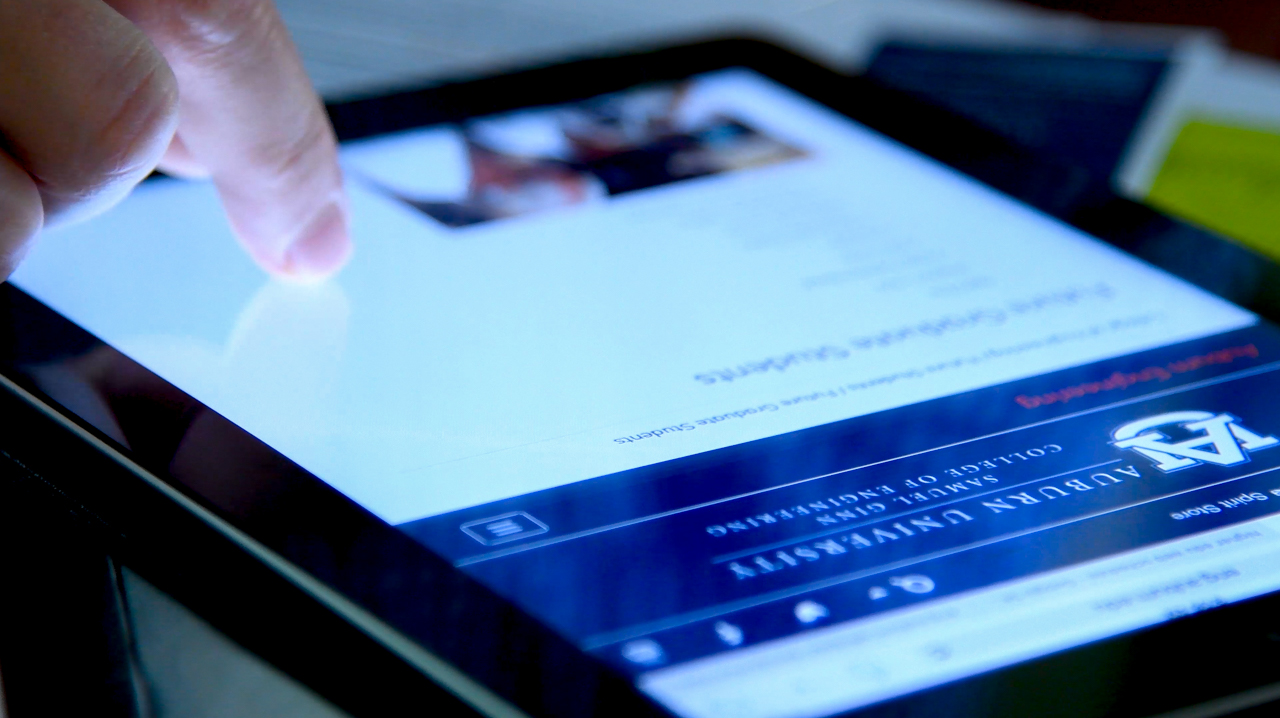 Auburn University is using a new $4.7 million grant from the National Science Foundation to address a shortage of public sector cybersecurity professionals.
Auburn University is using a new $4.7 million grant from the National Science Foundation to address a shortage of public sector cybersecurity professionals.
The award is part of NSF’s CyberCorps Scholarship for Service (SFS) program that provides students with scholarships and stipends to fund their education in a cybersecurity field in return for service to a government agency after graduation.
A longtime participant in the SFS program, Auburn is using the new grant to expand its involvement in the program, recruit students from underrepresented populations, and raise cybersecurity awareness in Alabama communities.
“In recent years, there have been many high-profile cyberattacks on our nation’s institutions, underlining the importance of Auburn’s education and research initiatives in this area,” said Dr. Christopher B. Roberts, dean of the Samuel Ginn College of Engineering. “This funding from NSF will support our work in preparing the next generation of cybersecurity professionals so they are capable of addressing this ever-evolving threat.”
Auburn’s SFS program is open to undergraduate and graduate students studying computer science, software engineering, computing engineering, wireless engineering, or electrical engineering. The program is overseen by Dr. David Umphress, the COLSA Corporation Cyber Security and Information Assurance Professor and director of the Auburn Cyber Research Center, and Dean Hendrix, associate professor of computer science and software engineering.
“We try to give students real-world, hands-on experience so they are able to perform cybersecurity functions by the time they graduate,” Umphress said. “Every summer, they have to participate in an internship at some type of public employment, such as the Department of Homeland Security, NSA, CIA, FBI, or places like that.”
As a stipulation of the scholarship, recipients must work in a cybersecurity position for a term equal to the length of the scholarship at the federal, state, territorial, local, or tribal level.
Tyler Hoover, a master’s student from Phenix City, Alabama, has been in Auburn’s SFS program for two years. The scholarship has allowed him the opportunity to not only continue his education past the bachelor’s degree, but also intern with the Department of Homeland Security. “In terms of the internships I have done, I would never have had those opportunities if it weren’t for the scholarship,” Hoover said.
Faculty members encourage students to pursue additional cybersecurity certifications outside the classroom. In addition, graduate students in the program conduct research in an advanced cybersecurity area with the goal of producing a publishable paper of relevance to public agencies. Auburn’s SFS team is working closely with the Alabama Power Academic Excellence Program and 100+ Women Strong within the College of Engineering, as well as Auburn’s Office of Accessibility and Veterans Resource Center to ensure at least half of the scholarship recipients come from underrepresented populations.
Outside of the classroom, the grant is allowing Auburn to raise awareness of cybersecurity issues throughout Alabama.
“We’re distinguishing ourselves from other SFS schools by embracing our land-grant heritage,” Umphress said. “For the next five years, we’re going to be partnering with the Alabama Cooperative Extension System to try to work with the citizens of Alabama to better understand cybersecurity.”Auburn has built a broad portfolio and strong reputation in the field of cybersecurity over the years. The university is a National Center of Academic Excellence in Cyber Defense Education and one of 19 National Centers of Academic Excellence in Cyber Operations, both designated by the National Security Agency.Going beyond cyber education, Auburn also has several research initiatives and centers focused on cybersecurity, including the Auburn Cyber Research Center and the McCrary Institute for Critical Infrastructure Protection and Cyber Systems.
For more information about Auburn’s SFS program, visit aub.ie/CyberCorps.
RHODES SCHOLAR MATTHEW ROGERS
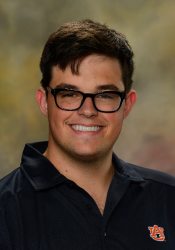 For Matthew Rogers, a senior in software engineering, the road to success starts with the Rhodes Scholarship.
For Matthew Rogers, a senior in software engineering, the road to success starts with the Rhodes Scholarship.
Rogers was one of only 32 students from around the United States selected for the prestigious scholarship, which funds graduate studies at the University of Oxford in the United Kingdom. He is the fifth Rhodes Scholar in Auburn’s history.
Once Rogers finishes his degree this spring, he will pursue a doctorate in cybersecurity at Oxford. “A lot of our students are just rock stars, but when you talk about the rock star of the rock stars, that’s what Matthew is,” said Dr. David Umphress, the COLSA Corporation Cyber Security and Information Assurance Professor in the Department of Computer Science and Software Engineering. “Achieving this honor – the Rhodes Scholarship, especially in the cyber field – is something really special.”
As a student in the Samuel Ginn College of Engineering and the Honors College, Rogers has maintained a 4.0 grade-point average and has served as an undergraduate research fellow working with IBM on a Trusted Platform Module crypto-processor to create secure exchanges of information. He worked three summers as an undergraduate research intern at the Huntsville-based Dynetics Inc., where he helped develop malware analysis tools. At Auburn, Rogers is an Honors College Ambassador, Undergraduate Research Ambassador, co-founder of the Auburn Ethical Hacking Club, past treasurer for the Auburn chapter of the Association of Computing Machinery, and a volunteer assisting Cyber Patriot teams in their preparation for competition. As he prepares for the challenge of being a Rhodes Scholar, Rogers says he is excited that Oxford’s cyber security program goes beyond the technical aspects and looks at cyber security through an international relations lens as well. “One of the main things that interested me about it is that it looks at cyber security and cyber from a multidisciplinary perspective,” he said.
I BELIEVE IN THE HUMAN TOUCH
New building expands opportunities for nursing faculty simulation research and hands-on student learning
By Amy Weaver
Simulation research is a growing necessity at many nursing programs, including Auburn’s School of Nursing. The need exists because schools nationwide are reporting budget reductions, a shortage of qualified faculty, and a lack of available clinical sites, forcing educators to develop creative ways to make students proficient in nursing skills and knowledge by graduation.
“Nursing is considered a practice profession,” said Auburn Assistant Clinical Professor Sarah Watts. “If students can’t train at clinical sites because of limited availability, we have to identify other opportunities for learning applied skills.”
At Auburn, the answer is the Engaging Active Group Learning Environments in Simulation (EAGLES) Center, a dedicated space in the School of Nursing’s new 89,000-square-foot building.
The center itself exceeds the square footage of Miller Hall, the school’s former home, and includes a skills lab and multiple simulation suites that mimic actual hospital, clinic, and community settings.
“The goal is to provide realistic situations in order to increase student confidence, decrease errors, and promote quality and safety in nursing clinical practice,” said Karol Renfroe, assistant clinical professor and nursing resource center coordinator.
In the EAGLES Center, a typical student experience begins with students receiving learning objectives, expectations of performance, and a patient-specific report in pre-brief. Students then enter the simulation suite where they assume the care of their patient(s) in either the simulated hospital, clinic, or community room. Following the scenario, students participate in a de-briefing session. Watts said research has indicated the guided reflection that occurs in de-briefing is vital to student learning.
Meghan Jones, assistant clinical professor and director of clinical simulation and skills, said it is important for students to hone their skills in an environment where mistakes can be made without compromising patient safety. The confidence they acquire from the simulated learning experience will carry over to clinical practice, she said.
The center not only allows educators the opportunity to ensure all graduates are proficient in discipline-specific knowledge and skills, and prepared for clinical practice, but it also provides the environment to conduct rigorous studies in order to add to the science of simulation.
Watts, a key player for Auburn’s simulation research efforts, was one of two people in the country selected for a 2017 research fellowship from the International Nursing Association for Clinical Simulation and Learning. The 15-month program was designed to develop future leaders in simulation research.
“This innovative method to prepare students is an integral part of the future of nursing education, and the talented faculty at Auburn are excited to advance the profession through simulation research,” she said.
Mike Callihan, a new assistant clinical professor coordinating simulation in the School of Nursing, said, “With the expanded need for simulation experiences, research into the most effective simulation methods is required to enhance the learning experience and produce graduates with clinical knowledge and clinical judgment skills.”
CHANGE AGENTS
Graduate School researchers solve problems at home and abroad
By Morgan Gregg
The work of Auburn graduate students not only benefits the citizens of Alabama but people around the world. Using state-of-the-art technology, Auburn students are helping us understand how to combat diseases, how to travel more safely, and how to improve overall health. Researchers in the College of Veterinary Medicine use the Auburn Laboratory for Imaging Animal Systems (ALIAS) to better understand progression of diseases, such as cancer, through a variety of noninvasive imaging technologies used to monitor changes in the tissue of living animals at cellular and molecular levels in real time.
In the field of entomology, Esther Ngumbi, 2011 doctoral graduate, discovered microscopic bacteria living in the soil can change the chemistry of a plant so that it repels insects. Her research led to a US patent and to companies pursuing rights to create commercialized products. Ngumbi hopes her research will help Kenya, her native country, and Africa as a whole.
While Ngumbi’s focus is on agricultural production, other students are researching ways to make traveling safer. Mechanical engineering students Tanner Ray and Dan Pierce are developing and improving technology to navigate pedestrians and ground vehicles. Applications of this technology for vehicles involve safety features, navigating GPS-denied environments, and autonomous vehicles. Madison Chandler is taking her passion for others to the next level. As a doctoral pharmaceutical sciences student, Chandler continuously works to identify mutations in certain cancer risk genes that cause hereditary breast and ovarian cancer syndrome. Eighteen years ago, Chandler’s uncle was diagnosed with clival chordoma, a deadly disease with a life expectancy of seven to nine years after diagnosis. Despite statistics, Chandler’s uncle lived for 18 years after his diagnosis. After witnessing her uncle battle a life-threatening disease, she decided to pursue an education in drug discovery and development.
Throughout her time as a student, Chandler’s research has focused on fighting deadly disease, but more specifically, finding ways to fight cancer genetics, predominantly in African American women in Alabama.
Much of the research on cancer genetics focuses on individuals of European descent. Chandler aspires to expand the information known about cancer genetics in other ethnicities to address cancer disparity issues. Many disparities can be attributed to socioeconomic factors, but biological factors can play a significant role.
“African American women have a higher incidence rate of breast cancer under the age of 40, which is a hallmark of hereditary breast cancer,” Chandler said.
Chandler’s native Alabama is one of the most medically underserved areas in the country, making it a great place for her to conduct research. Chandler engages volunteers through educational sessions, which allow participants to ask questions in a non-intimidating environment.
Once people have attended an educational session, they are more knowledgeable on breast cancer risk genes and can spread the word to family and friends, creating a large network.
Educational sessions also help establish trust and give people an opportunity to become involved in research.
Chandler and her professor, Dr. Nancy Merner, attend breast cancer awareness events, including Relay for Life, with the mobile Gene Machine to recruit volunteers to assist their research.
The Gene Machine is a pink bus that contains all the equipment necessary for Chandler to run tests and conduct research. Patients step inside the bus and experience what is similar to a room at the doctor’s office.
“We can travel to patients, so it is convenient for them, but we don’t have to unload all of our stuff and pack it back up,” said Chandler.
When she began her research with Merner, they talked about how a bus would allow them to take everything needed for recruitment without having to make multiple trips. At first, the discussion was somewhat of a joke, until they found a bus for sale—and bought it.
The Gene Machine, which debuted at the 2017 A-Day football game, is now being used to transport and recruit patients for cancer-risk gene testing.
In order to test for cancer-risk genes, Chandler does a targeted, custom-designed gene panel that captures 87 known and candidate breast cancer-risk genes. Following the gene panel, next-generation sequencing is carried out by HudsonAlpha Institute for Biotechnology in Huntsville, Alabama.
Chandler enjoys working with genetics and would love to do medical genetics postdoctoral training at a certified institution. Eventually, she hopes to become board-certified to run a clinical genetics lab in a hospital. Chandler took home the first-place title of the Three Minute Thesis competition held at Auburn in November 2016, going on to present her research at the Conference of Southern Graduate Schools in Annapolis, Maryland.
Chandler’s ultimate goal is to identify a novel risk that increases a particular population’s risk of breast cancer. With her passion for helping others and dedication to her research, Chandler seems well on her way to a successful future.
LAKIN’S RESEARCH HELPS BROADEN IDENTIFICATION OF GIFTED STUDENTS
By George Littleton
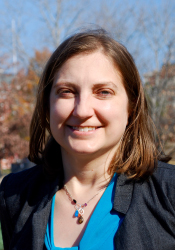 Few people realize how much scientific research goes into developing the tests children take in school. There is an entire field of study—psychometrics—focused solely on the statistical and theoretical underpinning of large-scale testing.
Few people realize how much scientific research goes into developing the tests children take in school. There is an entire field of study—psychometrics—focused solely on the statistical and theoretical underpinning of large-scale testing.
Ability testing is a specialization in itself. The field took off over a century ago when Alfred Binet conducted his seminal work on identifying academic capability that could be measured independently of socioeconomic status and access to formal education. Researchers continue to work to better understand how and why students excel or struggle, and continue to develop strategies and resources for teachers to help all students be successful.
The Cognitive Abilities Test (CogAT) is a widely- used assessment in grades K-12. It measures the reasoning abilities of students and is often used alongside measures of achievement and teacher ratings to plan instruction for students. The test measures verbal reasoning, quantitative reasoning, and nonverbal or figure-based reasoning, which reflects current knowledge of the different components of general reasoning ability.
CogAT can also be used by the general classroom teacher for differentiating instruction. Differentiation essentially means tailoring instruction to the particular needs of individual students or groups of students. For example, if CogAt scores indicate that a student has a strength in verbal reasoning but a weakness in quantitative reasoning, the teacher might encourage that student to explain math equations verbally so that he or she can use that strength to build up the weaker area. Differentiating instruction is a crucial strategy for allowing all students to succeed, but teachers sometimes struggle to get the information they need to adapt instruction. CogAT is especially well-suited to this use because of its measurement of three domains of reasoning: verbal, quantitative, and figural.
Joni Lakin, PhD, an associate professor in the College of Education, is working to update and expand the resources available for classroom teachers using the CogAT for the purpose of differentiating instruction. She collaborated with six Alabama teachers and a Samford University faculty member to revise the materials. Their goal is to help classroom teachers interpret CogAT scores and use test results to improve classroom instruction. Lakin is also interested in improving the use of the test for identifying students for specialized services such as gifted and talented programs.
“My research interest is how the CogAT can be used in identification systems to increase the diversity of gifted and talented programs,” Lakin said. “My research focuses on how we can modify the identification procedures to improve representativeness. One area I’m currently working on is promoting universal screening, which means you test all students on a quick assessment and then consider high-scoring students for additional testing. This gives all students a more equal chance to be identified for appropriate gifted and talented services.”
Lakin is partnering with Houghton Mifflin Harcourt Publishing Company to create resources for educators around CogAT. She is conducting training webinars on topics teachers and administrators have requested, including universal screening and appropriate uses of test scores. Each year, Lakin travels to teacher conferences to talk about CogAT and her related research. She will present at the National Association for Gifted Children this fall and at regional conferences in Alabama and British Columbia in Canada.
Lakin has published no fewer than a dozen peer-reviewed articles on the topic and continues to be a national leader in the field.
AUBURN HUMAN SCIENTISTS FIND ANSWERS WITH HUMAN-TECHNOLOGY INTERFACE
By Amy Weaver
Researchers in the Department of Consumer and Design Sciences in the College of Human Sciences are seeking solutions with the human-technology interface to understand how humans comprehend, interact, and use the world around them.
Decision-making in the Digital Age
Professor Veena Chattaraman wants to help consumers make smarter decisions.
“People have access to increasing amounts of information literally at their fingertips, however, they have less and less time to process that information and reach a decision,” she said.
Rather than make poor uninformed or desperate decisions, Chattaraman has found a solution: the use of mobile decision aids (MoDA). The application is meant to help consumers make efficient decisions that best suit their needs.
Chattaraman said MoDA is intelligent and retrieves information for the consumer’s decision-making process based on what they want from the product they are seeking. It will not overwhelm the consumer with information, but rather use information from sources such as customer reviews and manufacturer’s specifications to allow the consumer to make an accurate decision.
“Ultimately they’re making the decision, but MoDA augments the natural way in which they make it by providing an intelligent retrieval of information and supporting their preferred decision-making strategy,” she said.
MoDA uses conversation protocols—as people interact with it—to infer how they are thinking about the decision. This ability makes MoDA more usable to those who want to make decisions on-the-go and in multitask situations.
Chattaraman’s research is funded by a three-year grant from the Cyber-Human Systems program at the National Science Foundation. A mock retail space in Auburn’s Radio Frequency Identification Lab (RFID), provides an environment for her research team to examine and capture decision dialogue from consumers.
“We’ll have consumers talk through a decision so we know what different steps they follow,” Chattaraman said. “We can use that to train MoDA to be able to understand that type of conversation and respond intelligently.”
Urban Furniture in the Digital Age
Assistant Professor Melanie Duffey became interested in studying public space users’ behaviors as a response to claims questioning the importance of physical public spaces within the digital age.
She plans to demonstrate how integrated technology might also be used to enhance or repurpose vacant and under-utilized public spaces using moveable urban furniture with digital charging capabilities, with the hope to integrate sensors and other tech devices in the future.
Duffey found people embrace public spaces with free Wi-Fi, even standing in an odd location because the signal strength was stronger.
On Auburn’s campus, where Wi-Fi is readily available, Duffey said she and graduate student Suzanne Merlino wanted to develop portable furniture for the knee walls around campus. The pair was curious if students would sit longer and use them more if they were able to charge their devices.
Such furniture—easy to manufacture, relatively low-cost, and of modular construction in order to ship flat—could have uses in rural communities or even disaster areas if it were to able to integrate more technology.
The end result is a portable chair with solar capabilities for device charging. From testing it on the Haley Concourse this spring, the team received feedback that indicated students generally enjoyed using the chair, but its design could be modified.
Apparel Design in the Digital Age
Assistant Professor Sarina Sun is studying how apparel designers react to the different technology interfaces, such as 3D computer-assisted design programs, and devices related to such applications, like 3D body scanning technology.
So far in her research, Sun said she has found there to be a steep learning curve for traditional apparel designers to adapt to the 3D virtual design environment as they are more visual minded, compared to the abstract minded engineers.
“We often are hands-on in traditional training and practices, where we rely on tactile sensation and haptic manipulation,” she explained. “However, in the virtual environment, we need to convert what we already know in the physical world into new digital actions using keyboard, mouse, and software commands. This mental process essentially involves the way we apply spatial visualization skills.”
Many designers are emerging as self-taught, influenced by the popularity of the maker movement, and are entering different roles in different industries traditionally only available to experts. Sun said this is likely a reflection of how quickly the digital fabrication technologies are saturating our society and how much more accessible and user friendly they are becoming.
Another part of Sun’s research involves the use of digital fabrication methods to overcome current challenges in apparel and textile supply chain.
“Innovative manufacturing technology would allow for a much shorter lead time and more diversities in the business model, leading to economic vitality,” said Sun. “Domestically, the effective use of digital fabrication methods may allow a small company to develop, market, and maintain a business using a unique model that takes advantage of local labor, supplies, and technology services.
CHEMICAL WARFARE
Researchers help law enforcement stay ahead of synthetic drugs
By Matt Crouch
Mention the battle against drugs of abuse to almost anyone and they may talk about marijuana, cocaine, LSD, cocaine, methamphetamine, opiates, or others that are familiar to most. For those actively involved in tackling the problem, the list is actually quite complex and seemingly never ending, as manufacturers have branched more into synthetic compounds that attempt to replicate drugs and circumvent the legal process.
More often than not, law enforcement officers first learn of a new synthetic drug when called to an emergency room because of an overdose. While the patient may exhibit the effects of a known drug, test results may show some unexpected results.
When law enforcement personnel need more help in identifying these synthetic drugs and learning more about their effects, they may seek out the assistance of a forensic chemistry lab. One of the most respected of these labs is located at Auburn University’s Harrison School of Pharmacy (HSOP).
Led by Dr. Randall Clark, the medicinal chemistry team at HSOP, which includes Dr. Jack DeRuiter and Dr. Forrest Smith, has more than 100 years of experience in analyzing and synthesizing these compounds.
Since 2006, the National Institute of Justice (NIJ) – the research, development, and evaluation agency of the United States Department of Justice – has awarded $9.5 million for in controlled substances research with Clark and his team receiving five of those awards, totaling nearly $2.5 million.
Clark sees the relationship among his group’s skillset and their established track record of working on these types of problems as being key to receiving one-quarter of the country’s NIJ research funding in the area of forensic chemistry of controlled substances.
The day-to-day challenge the group faces now is the explosion in the synthetic drug market. In 2016, more than 52,000 Americans died from drug overdoses, setting a new high-water mark. That total is almost as much as the number of fatalities from automobile accidents and gun deaths combined.
Meanwhile, from 2008-15, 102 countries and territories reported more than 650 new psychoreactive substances. Examples of these new psychoreactive substances include synthetic cannabinoids, bath salts, MDMA (ecstasy), along with other synthetic compounds meant to impersonate traditional drugs.
“The problems have become more sophisticated, complicated, and difficult,” said Clark. “Along with that, there are a large number of projects and problems that have come along as a result of synthetic drugs of abuse.”
Terms thrown around when discussing designer drugs include “boundary issues” and “imposter molecules.” Boundary issues refer to the fact that designer drugs are outlawed by their specific chemical makeup. So, making slight changes to the chemical makeup with imposter molecules could put the compound outside of the legal boundary.
That is where Clark and his team come in. For years, they have been analyzing and synthesizing these materials, proving information to law enforcement to help them stay up to date.
Recent work in this area includes studies of bath salts, which come about when cathinone, a naturally occurring compound, is synthetically restructured to provide a psychotropic effect 10 times more potent than that caused by cocaine. A study of synthetic cannabinoids derived from THC, the active ingredient of marijuana, illustrates how plant material can be soaked or sprayed with a drug solution and dried for smoking. This process creates material that is five times more potent than THC and has led to the inclusion of more than 100 novel cannabinoids in plant samples.
The higher potency of novel synthetic drugs has greatly affected abuse of opioids, as synthetic compounds are exponentially more potent. Examples include fentanyl, which is 200 times more potent than morphine with derivatives being 1,000 times more potent than morphine. Similarly, carfentanil is 10,000 times more potent than morphine and is lethal in miniscule doses.
The potency of the drugs even comes into play when attempting to analyze and study them, as simply inhaling them is potentially fatal.
“One of the significant issues is the synthetic opiates where quite often many of them are so much more potent than anything that people have dealt with before. The safety issue for the analyst, the policeman, and others is of much greater concern,” said Clark. “Quite often, having the antidote for these things in your hand as you go about trying to analyze or confiscate these kind of materials is important to counteract being overdosed by merely handling these materials. Some of these are so potent that they are sometimes referred to as chemical weapons.”
GENETIC MODEL
The genomic study of threatened wild free-ranging mouse lemurs is beneficial for research, conservation, and society
By Jamie Anderson
The Madagascar mouse lemur, a primate half the genetic distance between mice and humans, is the ideal candidate to transform the future of biomedical research, all while conserving the species and creating opportunity for the Malagasy people, according to a study published in the scientific journal, Genetics.
Dr. Sarah Zohdy, an assistant professor of disease ecology in Auburn’s School of Forestry and Wildlife Sciences and College of Veterinary Medicine, collaborated on the study, “The Mouse Lemur, a Genetic Model Organism for Primate Biology, Behavior, and Health,” along with several other scientists from the Department of Biochemistry and Department of Comparative Medicine at Stanford University, Howard Hughes Medical Institute, and the Department of Animal Biology at the University of Antananarivo, Madagascar.
The researchers have developed a new genetic model organism and a framework for how health and biomedical research can be conducted in a way that can simultaneously improve conservation efforts, contribute to the development and education of a poverty-stricken nation, and transform the future of biomedical research in a way that considers the biology and ecology of the organism to be critical for the advancement of our understanding of human health and well-being.
“We have a very thorough understanding of these organisms at the genomic and phenomic levels, possibly more than any other organisms on earth,” said Zohdy. “The animal model closest to humans physiologically is the mouse. However, it is now recognized that nearly 50 percent of the time the mouse model, or knockout, created to better understand human disease fails to present with the same symptoms as humans.”
A knockout mouse is a genetically modified mouse in which an existing gene has been inactivated or replaced with an artificial piece of DNA. This allows researchers to better understand the role of the gene in relation to its normal behavior or physiology.
Frustrated by the lack of a good study model, Dr. Mark Krasnow and his colleagues turned to the mouse lemur, the smallest primate in the world, found only on the island of Madagascar.
Though plentiful on the island, mouse lemurs, like all lemurs, are threatened due to habitat loss, and many species are considered endangered or critically endangered. Also problematic, the mouse lemur only produces four to six babies per year; thus, normal research methods of producing genetic knockouts using this species would require more time, since they do not reproduce as frequently.
Realizing the limitations of studying the mouse lemur in a traditional lab environment, Krasnow turned to Zohdy, an ecologist who has studied the natural history of wild mouse lemurs in the eastern rainforests of Madagascar.
Zohdy’s long-term research in Madagascar has produced a well-established field protocol with more than 500 individually identifiable wild mouse lemurs, many of which have been captured and recaptured annually for nearly 10 years.
It was during their initial meeting in 2010 in Madagascar that Zohdy discussed with Krasnow the societal and ecological benefits of studying the wild free-ranging mouse lemur.
“Instead of introducing mutations in mice or fruit flies, we are doing something much more similar to what is done in humans,” he said. “We are looking at all the wonderful genetic variation already existing in nature, since there are so many millions of mouse lemurs out there. We calculate that most knockout mutations are already present in nature, and all we have to do is find them. And because the cost of sequencing a genome is rapidly dropping, it’s now possible to sequence the genomes of thousands of mouse lemurs to see what mutations they are carrying.”
In doing so, the researchers could accomplish in a few years for a tiny fraction of the cost what the International Knockout Mouse Consortium will accomplish in 10 years, at a cost of nearly $1 billion, he said.
Establishing a field study in Madagascar, the researchers are building capacity on the island by teaching local Malagasy guides and students about mouse lemurs and training them in the use of modern genomic techniques.
“Technology is so advanced today that the ideal way to build capacity and educational programs in Madagascar while simultaneously working with a new model organism was to bring the 21st-century world of genomics to Madagascar,” said Zohdy.
At Zohdy’s research center and field site in Ranomafana, Madagascar, at Centre ValBio, the research team has created a sophisticated molecular biology and genetics lab where the scientists are able to conduct research in the field and use it as a training opportunity for Malagasy students.
The scientists report that they already have identified more than 20 individual lemurs with unique genetic traits, including obesity, high cholesterol, high blood sugar, cardiac arrhythmias, progressive eye disease, and motor and personality disorders. The lemurs have also been found to develop a form of dementia and accumulate plaques in the brain that resemble those of Alzheimer’s patients.
The full article is available at http://www.genetics.org/content/206/2/651.
A LEGACY OF DISCOVERY
THE PAST...
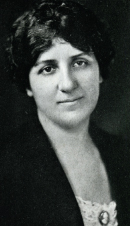
HARRIS 1922-1927 |

GATCHELL 1923-1956 |
1892, the first women students were enrolled in what is now Auburn University, but it wasn’t until 1919 that its first female teaching assistant, Kate Lane, was hired. Over time—from undergraduate coeds conducting experiments in the chemistry lab to women working
|
GALBRAITH 1970-1985 |
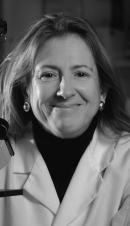
WOOTEN 1987-2010 |
as home demonstration agents in the 1910s and ‘20s, English instructors, home economics researchers, and eventually department heads and deans over the decades that followed—women researchers at Auburn have built a legacy that continues to flourish today.
When the Department of Home Economics was established in 1922, it gave Auburn women opportunities to conduct research with the novel home-making appliances and equipment of the era, under the guidance of Dean of Women Agnes Ellen Harris.
In 1923, Dana King Gatchell joined Auburn’s home economics faculty, was named a full professor in the Foods and Nutrition Department in 1935, and remained at Auburn for 33 years. She published guide books on menu planning, table settings, and food preservation, as well as numerous cookbooks. A women’s club at the university was named in her honor.
By 1950, Auburn’s catalog reveals female faculty in areas as diverse as mathematics, education, and bacteriology.
Following a career as a textile chemist for GE and DuPont (where she helped develop the first acrylic fabric, Orlon), Dr. Ruth Legg Galbraith began an academic career that led her to Auburn’s Department of Consumer Affairs in 1970. She became dean of the School of Home Economics in 1973 and held that position for twelve years. During her time at Auburn, Galbraith chaired the research section of the American Home Economics Association and oversaw a congressional advisory committee providing expertise for the US Flammable Fabrics Act. Galbraith still lives in the Auburn area and described her tenure at the university as a transitional period marked by “a very good faculty” that worked at “building towards a future.”
Dr. Marie Wooten joined Auburn’s Department of Biological Sciences in 1987 and later became department chair and then associate dean for research in the College of Sciences and Mathematics. Wooten was named dean of the college in May 2010. Her research focused on cellular and molecular developmental neurobiology and neurodegeneration, and in 2010 she discovered that the absence of a specific protein molecule in mice made them more likely to be obese and to develop Alzheimer’s disease. Tragically, Wooten died later that year in an accident, but her research findings and her impact on Auburn live on. Following her death, an endowed scholarship was established in her memory and has benefited 19 students in the College of Sciences and Mathematics. A distinguished professorship memorializing Wooten was also established to recognize a female professor of neurobiology who serves as a positive role model for her colleagues and students, as Wooten herself did for over 20 years at Auburn.
THE PRESENT AND FUTURE...
As the years have passed, doors of opportunity that once were shut have been opened to women researchers at Auburn in every field of study. From among the multitude of successful women currently engaged in a variety of research and creative scholarship endeavors across the university, here is but a sampling of highlights.
Dr. Lisa Samuelson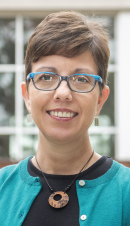 - 1994 - Present
- 1994 - Present
Alumni Professor and Dwain G. Luce Professor of Forestry
School of Forestry and Wildlife Sciences
During her 24 years at Auburn, Lisa Samuelson has published multiple books on tree dendrology and a popular reference website, Trees of Alabama and the Southeast. As director of the Center for Longleaf Pine Ecosystems, she collaborates with federal agencies, nonprofits, and colleagues from other universities to study carbon fluxes and carbon sequestration in longleaf pines, as well as the effects of drought and other environmental stressors on these trees. Since its inception, the center has received more than $4 million in extramural research funding.
As for the role of the pine tree in the region’s ecosystem, it’s more significant than you might think. “Southeastern forests offset about 38 percent of the region’s annual fossil fuel emissions” by sequestering carbon dioxide, Samuelson said. And about a third of those forests are pine. With an eye toward determining whether longleaf pine forests are more drought-resilient than other southern pine forests, Samuelson and colleagues “are studying drought effects on carbon and water fluxes at the leaf, tree, and stand levels,” she said. Reflecting on over two decades of research, Samuelson noted that her work has helped to advance knowledge of basic tree physiological processes, environmental impacts on trees, and forest management practices.
Dr. Cathleen Giustino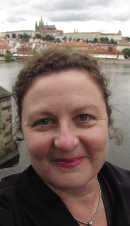 - 1997 - Present
- 1997 - Present
Mills Carter Professor
Department of History
A former Fulbright Scholar and 2017 Carnegie Fellow, Cathleen Giustino is no stranger to prestigious accolades. “My Fulbright allowed me to conduct research in a variety of archives and libraries in the Czech Republic,” Giustino said, adding that her Carnegie Fellowship enabled her to devote time to writing a book-length manuscript on her findings. “I am currently interested in questions relating to the transmission of racism and ethnic hatred through museums and material culture in central and eastern Europe,” she said.
In addition to a focus on the Czech Republic, her research has also taken her to Germany and Israel. “All of this work made me realize how often cities, historic architecture, and works of art and antiques in museums are comprised of layers of history,” she explained. “We might not immediately see those layers, but with some knowledge and contemplation, they can become visible to us.” Giustino has also examined the history of toy design in socialist Czechoslovakia and what it reveals about children’s experiences in the former Soviet bloc. Her future plans include research on women and bijouterie, or fashion jewelry, in Czechoslovakia during the Cold War. The project, she added, will look at industry and women’s work in the region, as well as “transnational relations across the not-so-iron Iron Curtain.”
Dr. Jin Wang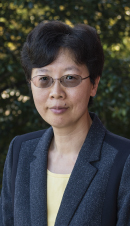 - 2006 - Present
- 2006 - Present
Walt & Virginia Woltosz Professor
Department of Chemical Engineering
The “practical value” of research is very important to Jin Wang. Engineers “have to develop useful solutions, not just beautiful papers,” she noted with a laugh, as she chatted about her 12 years of work at Auburn.
A systems engineer by training, Wang brings her practicality to bear in two focus areas: biotechnology development and smart manufacturing. “On the surface, they may look completely different,” she explained, “but the commonality between these two areas of application is that we focus on understanding the complex dynamics of the system.”
The outcome is research that has identified novel co-cultures of microorganisms that function together to convert biogas, produced from wastes, into feed ingredients for commercial aquaculture operations. (Microbes from the biogas serve as a source of “single-cell protein” similar to what fish would feed on in their natural environment.) Wang and colleagues have two patents pending for the process.
On the smart manufacturing side of things, Wang is working to help manufacturing facilities, like chemical plants, analyze large quantities of process data to glean information that helps improve decision-making and automation. “If you go into any chemical plant,” Wang explained, “you will see data. They collect tons of data, but most of it is just stored, unless something went wrong. No one would have the time or the tool to look into the process data.” But she and her team are working to fix that. “Basically, how do you dig out the gold from that pile of sand?” she asked. “And that’s really an extension of the statistical analysis tools we developed that we want to advance.”
The bottom line across her research program, she noted, is the value proposition. Researchers should play to their strengths, Wang said, and “pick an important problem to address that has practical value.” Clearly, she continues to do just that.
Dr. Emefa Monu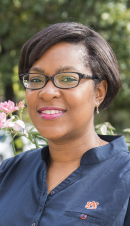 - 2015 - Present
- 2015 - Present
Assistant Professor
Department of Poultry Science
Research runs in Emefa Monu’s family. Her father is a professor, her brother an assistant professor. But her path to a PhD and a career in research has been all her own—from undergraduate research in nutrition and food science labs to a master’s in food science, and then on to her doctoral degree and post-doctoral work in food science and technology.
Monu’s current research focuses on antimicrobials, compounds used to prevent food-borne illnesses like E.coli, salmonella, and listeria. In particular, she has tested natural compounds from such sources as white mustard essential oil extract and guava leaves, to determine their effectiveness in deterring both food spoilage and food-borne illness. “The whole reason behind the search for these antimicrobials is that a lot of food companies are going towards more natural, clean-label food products, because that’s what consumers are looking for, to kind of meet that organic and natural demand,” Monu said. She added, “The way I think about it is, in addition to doing research that furthers scientific knowledge, it’s our job to help the food industry as well.”
Monu has also been working with Dr. Mark Liles in Auburn’s Department of Biological Sciences to study novel varieties of bacteriocins, or antimicrobial peptides produced by bacteria. These may also prove useful in warding off certain food-borne pathogens. And while her research itself has proven rewards, she is quick to point out that Auburn’s welcoming atmosphere has only added to the experience. “I’ve really enjoyed my time at Auburn so far,” Monu said. “The whole ‘Auburn Family’ mentality—I’ve definitely felt that.”
BRIDGE PROGRAM INCREASING DIVERSITY, TRAINING FUTURE RESEARCHERS IN COLLEGE OF EDUCATION
By George Littleton
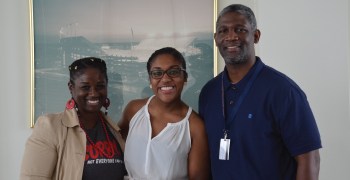
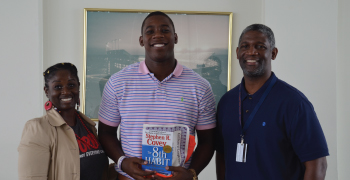
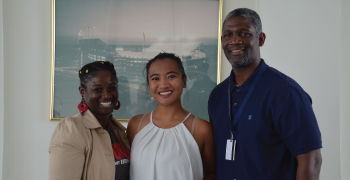
Summer 2017 marked the seventh consecutive year kinesiology Professor Jared Russell, PhD, has hosted the Future Scholars Summer Research Bridge Program. The program began with the intent of increasing the cultural and ethnic diversity in the College of Education’s graduate programs and sending scholars of color into the academy. By any measure, it has been a spectacular success.
“We’ve done really well with the program,” Russell said. “The only drawback at this point is that most of these scholars have come.into the School of Kinesiology, whereas the intent is for the program to benefit all units of the college. Now that we’ve got the program rolling, I hope we can recruit more students for other academic areas.”
The program began in 2010, when Russell reached out to faculty at his alma mater, Morehouse College in Atlanta, which has its own undergraduate kinesiology program. He also established relationships with Spelman College in Atlanta and Albany State University in south Georgia. These are three of the state’s historically black colleges and universities (HBCUs).
On these visits, Russell talked to promising undergrads about Auburn University as a place to do graduate work and conduct research. To his surprise, few had heard of Auburn, much less considered coming here.
“It took some time to get the word out about the wonderful opportunities at Auburn University, but now we have solid relationships with a number of HBCUs in the region,” Russell said. “The College of Education has multiple academic programs that have recruited graduate students from diverse backgrounds. Consequently, we now have a critical mass of ethnically and racially diverse students in the college. That has that’s been a huge stride forward and has helped our Bridge students feel more at home, particularly when they eventually enroll in graduate school here. A network of support has already been established with faculty, staff, administrators, and especially students. But we still have much work to do.”
Back to the future
In the program’s first year, 10 students enrolled in the Summer Bridge program. Six of those students went on to enroll in graduate school here. Over the years, Russell said, approximately 80 percent of the Bridge students end up coming here to graduate school.
“Of the approximately 30 or so students who have enrolled here from our Bridge program, every one has gotten at least a master’s degree, with a few now pursuing the doctoral degree,” he said. “And that’s one reason so many of these students are in kinesiology—we have a one-year master’s program. Most master’s programs take longer. Students understand they can receive a quality educational experience, professional development, and preparation for their future careers in a relatively short amount of time.”
After his initial success in Georgia, Russell’s recruiting territory expanded to Tuskegee University and Alabama State University, both close to Auburn. He expanded the program to include students from Tennessee State University in Nashville, Florida A&M University in Tallahassee, and North Carolina Central in Raleigh. A recent kinesiology doctoral grad, Desmond Delk, is on the faculty at Langston University in Oklahoma, so students have started coming from there. The program is well-known within the ranks of the American Kinesiology Association, which has led students to Auburn from as far away as the University of California, Fullerton.
“As our Bridge students graduate and enter the academy and profession, they act as ambassadors for the program,” Russell said. “Each success can lead to another success. Director of the School of Kinesiology Dr. Mary Rudisill and I set a goal to graduate 10 doctoral students from the program in 10 years. We are on track to meet and exceed that goal. This speaks to the preparation and support for these students by the College of Education, the School of Kinesiology, and the university in general. This is a model that works well for everyone involved.”
Student-run, faculty-directed
The six-week program, which runs from mid-May to until the end of June, is as much about preparing students for the rigors of graduate studies as it is about conducting research. The students are in class every day and work with faculty members on a research project they select themselves. But there is much more going on.
“A lot of it is socialization,” Russell said. “We talk about how to apply to graduate school and how to find ways to fund graduate study, which is a major challenge for most students in general. We emphasize the soft skills, including professional, business, and social etiquette. We explore the best ways to approach professors and office hours and grade discussions. And we engage in multiple service projects by assisting in outreach activities held by the School of Kinesiology every summer.”
All of these activities involve current graduate students, and most sessions are designed and implemented by past program participants.
“We say that our Bridge program is student-run and faculty-directed,” Russell explained. “The majority of the graduate students working with the program have been in the Bridge students’ shoes, so they can relate. Students have a much better sense of what other students want and need than do faculty members. They’ve lived the graduate experience.”
The work starts long before the Bridge students arrive on campus.
“Our program mentors review applications, conduct Skype interviews with applicants, and ultimately provide me with a list that states the strengths and drawbacks of each applicant, with recommendations about who should be admitted. We always have more applicants than we admit, and pretty much everyone we admit chooses to come to Auburn for graduate studies.”
Isolation for traditionally underrepresented students is a real issue at predominantly white institutions, so mentors help them understand that graduate school is a collaborative venture. The mentors encourage socialization and becoming part of the larger Auburn University community.
“On our last day, graduation day, each Bridge student presents on their area of research, but part of this exercise is helping them experience what it really means to make a research presentation to a large, live audience. I’d say that academic readiness is not the issue with these students. They’re bright and energetic. The Bridge program seeks to ease the transition and social adjustment of the students so they are confident in their abilities to succeed as graduate students.”
Funding remains an issue
The cost of the summer program is approximately $5,000 per student. Much of that funding comes from an annual gift from the Charles Barkley Foundation. Russell wants to expand the program to include other units in the college, but funding remains the sticking point.
“The real challenge is to support their graduate studies, via assistantships or fellowships, once they choose to enroll at Auburn,” he said. “Funding is an issue for any graduate student. As part of our recruitment and retention efforts we work to provide that critical support so the student chooses Auburn over other institutions.”
“We now have a critical mass of diverse students in the College of Education,” Russell concluded. “The infrastructure is really in place to allow the program to take off and be implemented in a number of academic programs, but we are just not sufficiently capitalized for a significant change in the number of students who would be able to participate. However, we have very, very strong support from College of Education Dean Betty Lou Whitford, Graduate School Dean George Flowers, School of Kinesiology Director Mary Rudisill, and the College of Education’s development office. We wouldn’t be at this point without them. The goal now is to continue to work and develop the means to build a sustainable college-wide program. And we’re working on that every day.”
For more information on funding opportunities for this program, contact Molly McNulty, College of Education development coordinator, at 334-844-5793 or mbm0010@auburn.edu.
THE NEXT BIG IDEA
The Auburn Research and Technology Foundation (ARTF) translates Auburn University research into new ventures, nurtures those ventures, and provides an entrepreneurial environment where those businesses can prosper. ARTF fosters public-private partnerships that leverage university resources to advance economic development and is adding to Auburn’s growing entrepreneurial ecosystem—an environment that includes the Auburn Research Park.
businesses can prosper. ARTF fosters public-private partnerships that leverage university resources to advance economic development and is adding to Auburn’s growing entrepreneurial ecosystem—an environment that includes the Auburn Research Park.
Auburn Research Park is a 171-acre, mixed-use entrepreneurial research and business campus focusing on technology/knowledge-based businesses, research centers, and university research facilities. The park houses 48 distinct entities, employing 253 full-time and 55 part-time employees, 38 faculty, and more than 150 students. Park occupants represent diverse research interests in fields ranging from aerospace to aquaculture, and it’s home to the Auburn Business Incubator and the Tiger Cage Accelerator.
The Auburn Business Incubator is a full-service, mixed-use business incubator launched in 2011 with the overall mission of assisting startup and early-stage companies by linking them to an array of services from both university and community sources. The incubator is designed to help launch, nurture, and accelerate the development of entrepreneurial companies by providing them with the expertise, networks, and services needed to become successful.
ARTF works closely with the Harbert College of Business to facilitate, sponsor, and house a number of programs for students including Tiger Cage Accelerator, a newly created collaborative, co-working space housed in Research Park’s Building 570. The Tiger Cage Accelerator and Auburn Business Incubator play a significant role in providing two distinct areas for future entrepreneurs to develop and grow their startup ventures.
With three new buildings in the pipeline—including a child-care center, an administrative complex with increased incubator space, and a facility focused on health sciences—ARTF is developing an integrated master plan for the next phase of park development. Along with the Jay and Susie Gogue Performing Arts Center, slated to open in 2019, this next generation of direction and planning will position Auburn to transform the Auburn Research Park into a destination for innovation that anchors a vibrant mixed-use district, connecting the park, the Performing Arts Center, and the Jule Collins Smith Museum of Fine Art.
Looking ahead, the Auburn Research Park will increasingly be a community of innovation and economic development, where talented experts conduct cutting-edge research and pursue the next “big idea” for the betterment of Alabama and beyond.
RESEARCH ADMIN PROFILE TONY VENTIMIGLIA
Newly elected vice president and president-elect of NCURA
By Jonathan Cullum
During his 18 years at Auburn University, Tony Ventimiglia, director of proposal services and faculty support, has had many opportunities to collaborate with colleagues from peer institutions in 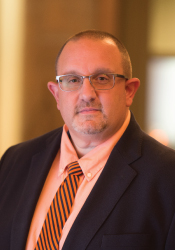 advancing the work of research administration. In January 2018, Ventimiglia’s platform for doing so expanded significantly, as he became vice president and president-elect of the National Council of University Research Administrators (NCURA), an international professional organization with more than 7,000 members.
advancing the work of research administration. In January 2018, Ventimiglia’s platform for doing so expanded significantly, as he became vice president and president-elect of the National Council of University Research Administrators (NCURA), an international professional organization with more than 7,000 members.
As the organization’s vice president for 2018, Ventimiglia will be responsible for organizing its 60th annual meeting, and when he takes over as president in 2019, he plans to help NCURA build stronger connections with university vice presidents for research, while also expanding the group’s global impact. In that regard, Ventimiglia already has considerable experience, having participated in NCURA delegations to both Russia and Cuba in 2016.
“Tony is the kind of person who puts 100 percent effort into everything that he does,” said Martha Taylor, Auburn’s assistant vice president for research administration. “Through focus, commitment and dedication to excellence in all things whether at home, in his work at Auburn, his commitment to our profession, or through his church, Tony helps to change the world.”
Ventimiglia noted that during his five-day visit to Moscow in 2016, sponsored by NCURA and the Eurasia Foundation, he participated in workshops and roundtable discussions with other American research administrators and their Russian counterparts and was “truly impressed” with the Russian education system and students he encountered. Thanks in part to the groundwork laid by Ventimiglia’s visit, along with efforts from Auburn’s Samuel Ginn College of Engineering and Office of International Programs, Auburn and Moscow’s State University of Railway Engineering (MIIT) signed a joint memorandum of understanding in 2017 to promote future research collaborations and student exchange between the two universities.
Through his work with NCURA, Ventimiglia said he hopes to help Auburn “continue to advance its global mission.”



